Helena Rubinstein (post 1945)
Continued from: Helena Rubinstein (1930-1945)
In 1945, Rubinstein travelled first to France, then England, to survey the damage caused by the war and revitalise her businesses there. The Paris salon was officially relaunched in 1948 after being refitted and redecorated. It took longer to normalise the operations in London as the salon there had been bombed during the Blitz. Rubinstein leased new premises at 3 Grafton Street, had it fitted out and the official opening ceremony took place in 1951.
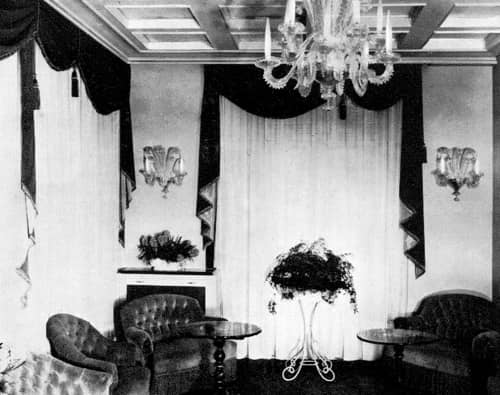
Above: 1955 Reception room in the Paris salon redecorated in Napoleon III style after the war.
While in France, Rubinstein bought an estate in the south of the country and, in 1946, announced that an experimental laboratory and plant would be opened near Grasse with the prospect that the company would soon begin the large-scale manufacture of perfume. The company would go on to introduce a number of new perfumes including Command Performance (1948), Noa Noa (1954) and Emotion (1965).
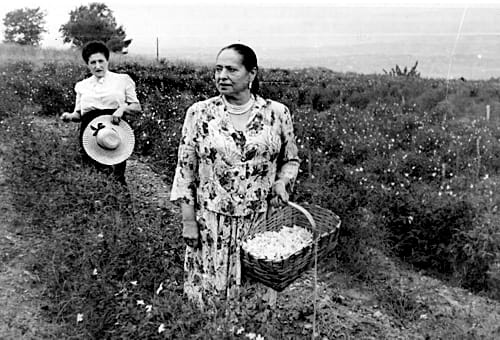
Above: 1951 Helena Rubinstein picking flowers in Grasse.
Back in the United States, the largest and most profitable part of Rubinstein’s beauty empire, the New York salon was in need of an upgrade. In 1948, she moved it and the company executive offices to 655 Fifth Avenue – uptown from the Elizabeth Arden salon at 691 Fifth Avenue.
Growth
The 1950s ushered in a period of global economic growth and rising living standards that lasted through to the 1970s. The market for cosmetics rose rapidly during this time and grew faster than rises in real incomes (Jones, 2010, p. 151). Rubinstein’s sales volumes went from US$13 million in 1945 to US$23 million by 1956, reaching US$34 million by 1965 (Fabe, 1972, p. 146) with the market in the United States being particularly strong. To accommodate the expanding American market, Rubinstein opened a new factory at East Hills, Long Island in 1953 and followed this with a new plant in California in 1954.

Above: Manufacturing, warehouse and shipping facilities at East Hills, New York designed by the architect Joseph Douglas Weiss [1895-1973]. Rubinstein had not forgotten the 1941 strike at the old plant and a lot of the production at East Hills was automated. This reduced labour costs and helped the company cope with rising production expenses.
The 1950s was not without its problems. There was greater competition from companies like Revlon and the cost of doing business in the American market was rising, in part due to the additional expense of advertising on television.
Promoting a product on television could be incredibly effective and, by the early 1960s, the American beauty industry was spending US$152 million on television advertising, more than any other sector except food (Jones, 2010, p. 157). However, its high cost meant that television was best suited to products that were mass marketed or had high profit margins.
Revlon and television
Established in 1932 as a small nail polish company, Revlon had been growing steadily and adding to its product line. Starting with lipsticks (1939), Revlon then followed with rouge (1940), face powders (1943), and eye make-up (1950), before branching into skin-care (1952).
See also: Revlon
As Revlon grew and its product line expanded, Rubinstein became increasingly vitriolic about the ‘nail man’, as she referred to Charles Revson [1906-1975], the head of Revlon. He was stealing her ideas and encroaching on her business. His move into skin-care was particularly irritating but after 1955 – when Revlon became the sole sponsor of a new television quiz show, ‘The $64,000 Question’ – there was little Rubinstein could do about it. Revlon’s sales almost double in 1955 and had more than doubled again by 1958, the year the program closed (Abrams, 1977, p. 64). Despite her animosity to Revson, Rubinstein could see Revlon’s potential and bought shares in the company when it went public in 1955.
See also: Revlon and ‘The $64,000 Question’
Rubinstein had been offered the sponsorship of ‘The $64,000 Question’ before Revlon but had turned it down. Belatedly, she tried spot television advertising in 1955 and 1956 but then dropped it and returned to print. In 1958, the company tried television advertising again, sponsoring the ‘Sid Caesar Invites You’ show on ABC-TV – with Rubinstein appearing in some of the commercials – but results were lacklustre.
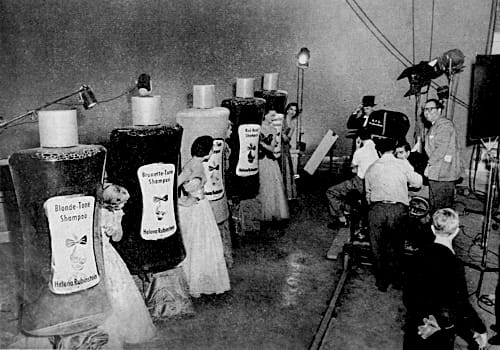
Above: 1955 Set for an Helena Rubinstein television commercial for Color-Tone Shampoos.
Salons
Helena Rubinstein’s global business had been built on luxury salons. As she expanded, she opened new ones to act as flagships for the brand. After 1945, they became harder to justify as their costs rose and their value as a marketing tool declined. Newer entrants into the cosmetic market, such as Revlon and Estée Lauder, created large businesses without them. However, while Rubinstein was alive, the luxury salons continued to operate much as they did before the war. Clients could continue to indulge themselves with a range of face and body treatments, have their hair cut, coloured and set, get make-up advice, have a makeover, and/or book themselves in for a range of diet and exercise programs.
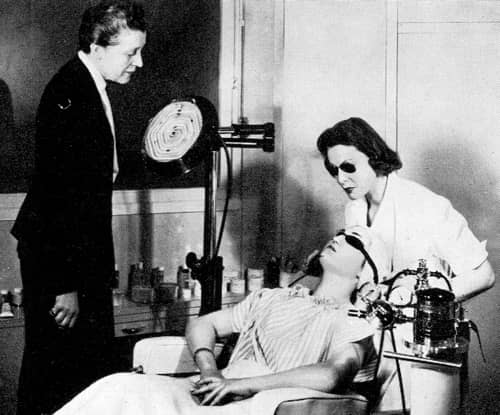
Above: 1955 Client undergoing a Néo-Régénérateur treatment in the Paris salon to erase spots and other skin irregularities.
Hairdressing became more important than beauty treatments as a revenue earner as women were prepared to pay a great deal for a session with a celebrity hair stylist.
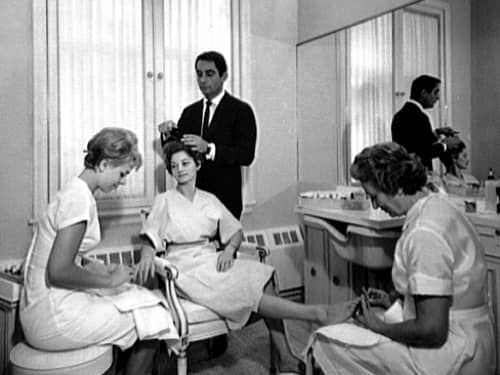
Above: 1961 Manicure, pedicure and hairstyling in the New York salon.
After Rubinstein’s death in 1965, the luxury salons were seen as costly liabilities rather than assets and the company closed most of them down (Woodhead, 2003, p. 416).
Above: 1963 Beauty treatments in Helena Rubinstein’s London Salon at 3 Grafton Street (British Pathé). The older woman is Ceśka Rubinstein [1883-1967], Helena’s sister.
Gourielli
Another problem for Rubinstein was what to do about the Prince Gourielli line for men and the Princess Gourielli line for women, both lines having failed to live up to expectations.
A decision was taken to turn the Gourielli building at 16 East 55th Street into a male-only establishment and Rubinstein hired Eleanor Guthrie McVickar – a former ‘Harper’s Bazaar’ beauty editor and Dorothy Gray advertising manager – to take charge of the operation. The repurposed establishment reopened in 1954 with the ground floor transformed into a men’s boutique selling clothes and other items and the second floor converted into the Gourielli Groom Shop where men could get hair cuts, hair treatments, scalp consultations, skin treatments, sun-lamping and other therapies.
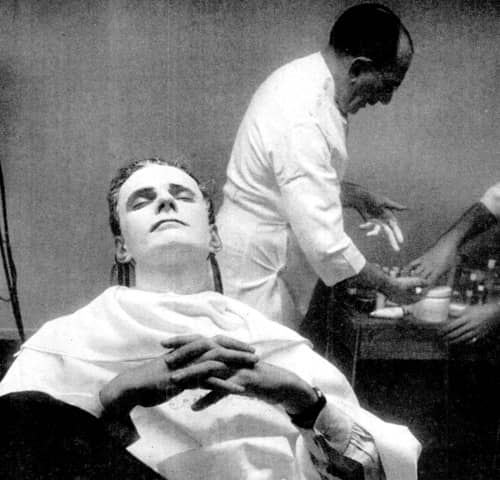
Above: 1954 Facial treatment in the Gourielli Barber Shop (LIFE).
The Gourelli East Street business lost money from the day it opened and after Prince Artchil Gourielli-Tchkonia died in November, 1955, Rubinstein closed the operation in the Gouriell building down in 1956. However, this was not the end of the line and a number of Gourielli cosmetics were still being sold in 1965.
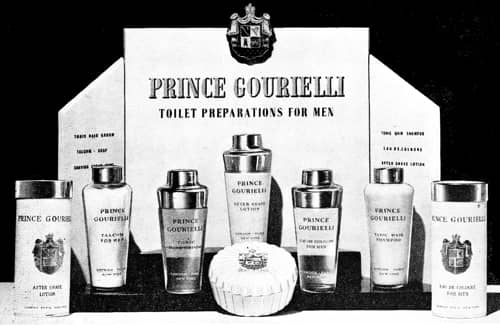
Above: 1955 Prince Gourielli Toilet Preparations for Men: After Shave Lotion, Talcum Powder, Tonic Hair Groom, Eau de Cologne, Shaving Cream Bowl and Tonic Hair Shampoo.
Beauty programs
Rubinstein’s reputation as a beauty expert had been reinforced by her numerous contributions to newspaper columns that offered beauty advice. This had been a favoured way for her to promote her business from her early days in Australia. In the 1930s, she had even structured some of her advertisements to look like advice columns. She continued with this idea after the war.
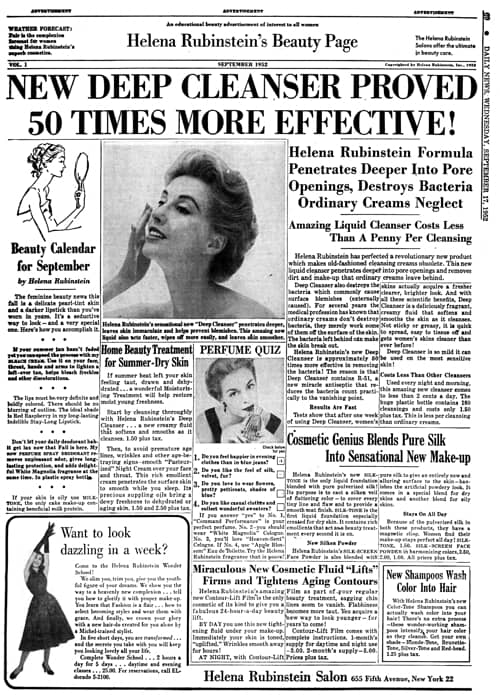
Above: 1952 Helena Rubinstein’s Beauty Page.
Along with newspaper columns, Rubinstein had conducted individual and group sessions for clients, educating them about skin-care and make-up and this also continued after 1945. Some of these were done through her salons, others through participating department stores or in rented spaces. The programs ranged from individual instruction through to small structured classes and on to demonstrations for large groups of women.
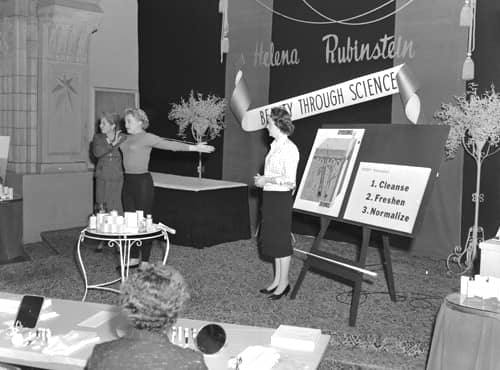
Above: 1959 Helena Rubinstein ‘Beauty through Science’ program being conducted in a large hall in New Zealand.
In 1942, Rubinstein had introduced the Five-Day Wonder Course Rubinstein in the United States. After the war, a two-hour condensed version of the course was created with many sessions being conducted by Mala Rubinstein. A small fee was charged to help cover the cost of the ‘Wonder Tray’ or ‘Beauty Box’ of product samples used on the day.
Each fact-filled two-hour class is a condensed version of the New York Salon Wonder Course that costs $25—you pay just $1! You’ll sit at a make-up table and give yourself a Salon treatment and make-up, following: motion by motion Miss Rubinstein and her staff. You’ll use famous Helena Rubinstein beauty needs from your individual Wonder Tray. You’ll learn Wonder Course secrets about diet, exercise, hair care—in fact, you’ll learn to make yourself over from head to toe.
(Rubinstein advertisement, 1949)
Rubinstein later made the Salon Wonder Course available as a free Home Beauty Course. Woman could follow the course after receiving a free skin analysis from an Helena Rubinstein consultant in her local department or drug store. The home course would go through various iterations becoming the 7-Day Beauty Plan by 1950.
A Complimentary Home Beauty Course. A complete 7-day Beauty Plan when you get your beauty analysis. It’s based on Helena Rubinstein’s famous New York Wonder Course for which women pay $25! The big illustrated 32-page book comes at absolutely no cost to you! It’s packed with everything about beauty care—how to exercise for a slim figure, guard your chin line, make your hair radiant, care for your skin, correct blemishes. There’s a 7-day diet, make-up color chart, eye make-up diagram—and dozens of other wonderful beauty secrets!
(Helena Rubinstein advertisement, 1955)
In 1961, Rubinstein converted the entire sixth floor of the New york salon into the ‘Little Theatre’. This could be divided into instruction rooms or set up to deliver lectures and demonstrations.
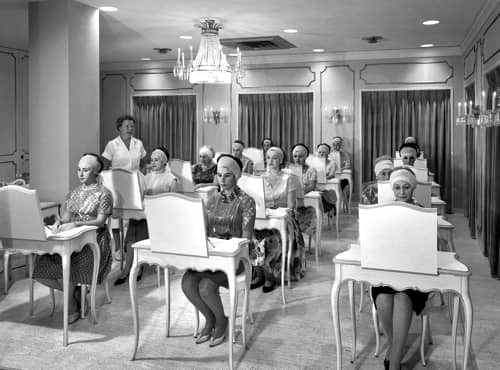
Above: 1961 Beauty class in the ‘Little Theatre’ in the New York salon.
Skin-care
Cosmetic regulation in America had become much tighter after the passing of the Food, Drug & Cosmetic Act (FD&CA) in 1938. The days of calling skin-care cosmetics ‘skin-foods’ and ‘nourishing creams’ were over – at least in the United States – and Rubinstein had to be more careful about the claims she made for her skin-care products in America if she wanted to avoid cease and desist orders from the Food and Drug Administration (FDA). Elsewhere in the world things were more relaxed.
Skin types
Before 1945, Rubinstein had based her skin-care routines on four skin-types – Normal, Oily, Dry and Combination. In the years after 1945 she also, at one time or another, made reference to Adolescent (Blemished), Mature (Ageing) and Sensitive skin types with Mature and Blemished receiving the bulk of her attention. Rubinstein would stick with these seven skin types and create morning and night skin-care regimes and make-up for each, along with specialist treatments such as masks and dietary advice. These changed over time as new cosmetics were developed but, by 1965, her general advice was as follows:
Dry skin must be moisturized and lubricated.
Oily skin needs scrupulous cleansing and refining.
Acne-blemished skin requires meticulous cleanliness and medication.
Sensitive skin like sensitive people must be treated with kindliness, gently soothes with bland beauty aids.
Ageing skin needs moisture and rich night creams. It must be assisted with such ‘look younger’ aids as stimulating lotions and creams.
Combination skin must be coaxed towards balance by the best two skin treatments—the techniques for coping with oily skin and with dry skin used simultaneously in needed areas.
Normal skin should be treasured and preserved with regular sensible skin care.(Rubinstein, 1965, pp. 129-130)
Salon method massage
Whenever a skin cream or lotion was applied, Rubinstein recommended using her ‘Salon Method’ massage movements. The movements themselves were light and their main purpose was to ensure that the various face-care cosmetics were correctly applied. The ‘age-betraying’ areas of the face were still said to get some benefit from massage but the pre-war suggestions that massage ‘exercised muscles’ or ‘stimulated nerve endings’ were downplayed.
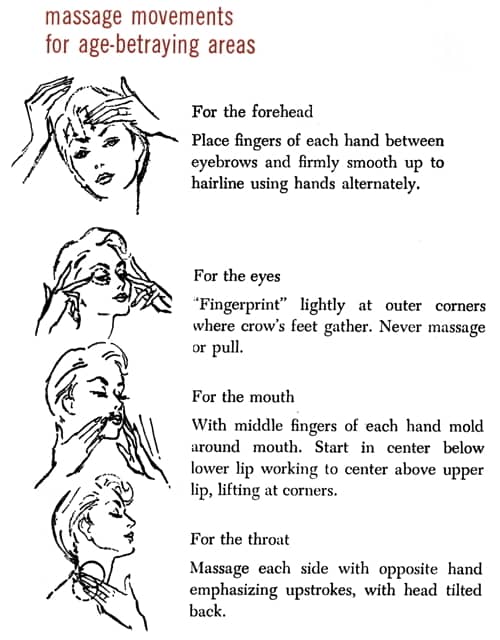
Above: 1954 Massage movements for age-betraying areas.
Mature skin
Rubinstein’s primary treatment for mature skin remained with hormone extracts and she continued to promote them despite growing medical opposition. In 1945, she replaced the Hormone Twin Youthifiers with the Estrogenic Hormone Twins – Estrogenic Hormone Cream (night) and Estrogenic Hormone Oil (day). Unlike the earlier Hormone Twin Youthifiers, both of these Hormone Twins contained oestrogens – 10,000 IUs (International Units) per ounce, the highest concentration allowed by the Food and Drug Administration (FDA) in the United States.
Estrogenic Hormone Oil: “All-day treatment for face, neck and under make-up. Absorbs instantly, leaves no oily trace.”
Estrogenic Hormone Cream: “Night treatment for younger-looking face and neck. Natural estrogenic hormones blended with easily absorbed lubricants.”
In 1948, Rubinstein then released Estrogenic Hormone Hand Lotion and Estrolar Throat Oil with oestrogens, the throat oil coming with a complimentary throat and chin strap when first introduced.
Estrolar Throat Oil: “Encourage a clean cut new throat line . . . discourage flabby muscles . . . crepey, aging lines! Use wonderful Estrolar Throat Oil along with Gourielli’s own effective new throat and chin strap! … Quickly absorbed! Perfect for twenty-four-hour use . . . wear it under your make-up foundation.”
To promote these products, Rubinstein occasionally advertised that her own ‘youthful looks’ were due to her use of oestrogenic cosmetics.
[Rubinstein] is famous for her line-free, carefree, youthfully beautiful complexion (though she is twice a grandmother!). Her secret? Helena Rubinstein has been using estrogenic hormones on her skin for over 35 years, ever since she made the revolutionary discovery of their beauty powers.
(Rubinstein advertisement, 1956)
However, portraits of her that accompanied these advertisements in the 1950s were doctored to remove lines and other signs of ageing often giving her a mask-like look.
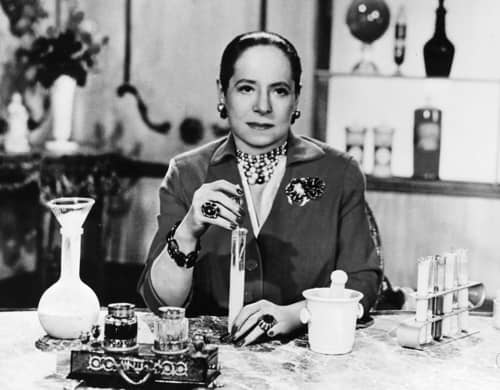
Above: Retouched portrait of Rubinstein used in a 1956 hormone advertisement when she would have been about 85 years old. She had been using hair dye for years.
Rubinstein included oestrogens in other cosmetics such as Silk-Tone Special with oestrogens (1952) and Young Touch Hand Lotion with oestrogens (1958). In 1957, she also added progesterone to the Estrogenic Hormone Cream.
Estrogenic Hormone Cream plus Progesterone: “Together with estrogen, the moisturizing hormone, progesterone re-activates your own oil glands to work as they do in a young skin! Your skin acts younger! Within weeks your skin will feel softer and have fewer lines, because new Estrogenic Hormone Cream with Progesterone actually corrects the dry skin condition that causes them!”
Progesterone was also included in her last hormone face cream she produced in 1959. Called Ultra Feminine, it contained 5 mg of progesterone along with 10,000 IUs of oestrogens per ounce.
See also: Hormone Creams, Oils and Serums
Important as they were, hormones were not the only skin-care cosmetic Rubinstein created for mature skin. For example, in 1952 she introduced Contour-Lift Film, following Elizabeth Arden’s Firmo-Lift Treatment Lotion released the previous year. Applied to the neck and face at night, Contour-Lift Film contained oils and astringents that Rubinstein claimed could combat lines, wrinkles, flabbiness and puffiness while being completely invisible.
Contour-Lift Film: “It tightens flabbiness . . . ‘lifts’ the sagging line of your chin . . . smooths down under eye puffiness. Overnight your contours look molded, tightened. Your profile looks years younger!”
See also: Elizabeth Arden (post 1945)
The product was frequently sold in a duo set either with Lanolin-Vitamin Formula or Estrogenic Hormone Oil.

Above: 1954 Massage movements for applying Contour Lift.
For additional help with firming the chin and throat, Rubinstein suggested doing a series of exercises after applying Estrogenic Hormone Oil.
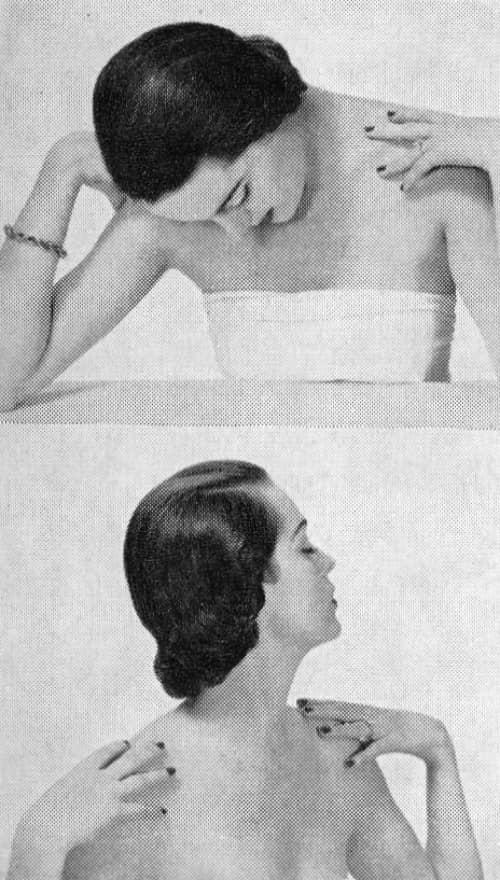
Above: 1954 Two exercises to help firm the throat recommended by Helena Rubinstein.
Also the company booklet: How to Solve your Beauty Problems (1954)
Blemished skin
Rubinstein’s treatments for blemished skin went back to well before the First World War. Amongst her medicated skin-care cosmetics released during the 1950s were: Deep Cleanser (1951), a liquid emulsion cream containing the proprietary antibacterial ‘R-51’, which was changed to ‘R-57’ in 1956, and then had the proprietary ingredient ‘Penetrel’ added in 1959; and Medicated Beauty Mask (1956). Rubinstein combined these with Water Lily Skin Lotion into a Medicated Beauty Treatment.
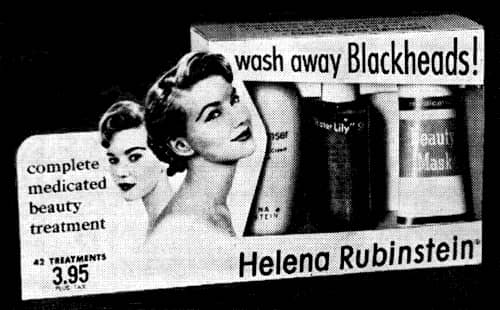
Above: 1956 Helena Rubinstein Medicated Pack. Steps to clear skin: 1. “Sterile”-Cleanse with Deep Cleanser; 2. Help heal and clear with Medicated Beauty Mask. 3. Tighten pores with “Water Lily” Skin Lotion.
Deep Cleanser: “[T]he sensational liquid cleansing cream that penetrates deeper into pore openings. It cleans your skin from the inside out, floats up every bit of sub-surface dirt and clinging make-up … contains the wonder-antiseptic R-51 which destroys bacteria that cause surface blemishes.”
Medicated Beauty Mask: “Its medications are the same ones prescribed by dermatologists as most effective in healing surface blemishes. ‘Un-masking’ was a momentous thrill for the women tested. As they washed off the mask they actually washed off blackheads and saw a clearer, smoother, younger-looking complexion emerge.”
In 1958, Rubinstein added Beauty Dew made with R-7 (hexachlorophene). Described as a ‘revolutionary liquid cold cream’ for busy women, but greaseless so that it ‘won’t stain the pillow’, it was a one-step cleansing, emollient and protective cream.
Beauty Dew: “[A] completely new greaseless liquid, scientifically formulated to do the work of many creams! … [C]leanses, softens, protects—and does it in just one minute. A completely new kind of liquid lanolin … penetrates deeper into the skin, softens deep-down, while R7 Hexachlorophene protects your skin against bacteria-caused surface blemishes.”
See also: Hexachlorophene
In 1960, Rubinstein introduced a new treatment for blemished skin containing two new medicated cosmetics, Bio-Cleanser and Bio-Clear Medicated Cream. Both cosmetics contained an organic sulphide – possibly a sulphanilamide – as the antibacterial ingredient.
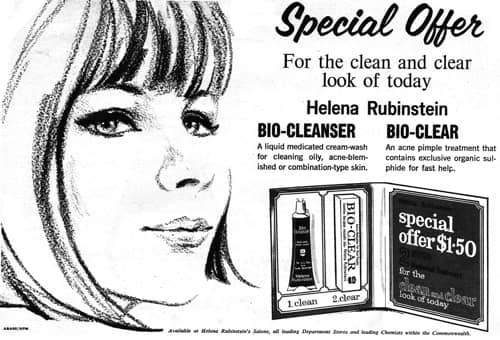
Above: 1967 Bio-Cleanser and Bio-Clear.
At the same time, Rubinstein reformulated her “Water Lily” Skin Lotion which now became “Water Lily” Pore Lotion (Medicated) and combined it with the other two products to produce a new three-stage treatment: 1. Wash away excess oil and blackheads with Bio-Cleanser; 2. Refine pores with medicated “Water Lily” Pore Lotion; 3. Clear your skin with Bio-Clear Medicated Cream. For additional help there was also Medicated Soap.

Above: 1961 Helena Rubinstein medicated products: Bio-Shampoo, Bio-Cleanser, Medicated Soap, “Water Lily” Pore Lotion (Medicated) and Bio-Clear.
Bio-Cleanser: This gentle but thorough medicated facial wash loosens and removes every speck of dirt, clears out clogged pores, helps heal skin.”
Bio-Clear Medicated Cream: “[I]s skin-toned for round the clock use. And even problem skins sensitive to some other acne preparations can use and benefit.”
Rubinstein added two other ‘Bio’ products in 1960 – Bio-Shampoo for dandruff and Biodorant a deodorant containing the antibiotic neomycin.
Also see: Antibiotics in Cosmetics
Additional ‘Bio’ products were introduced through the decade and, by 1970, what was then referred to as the Bio Clear range also included make-up.
Moisturisers
Rubinstein had been producing skin-care cosmetics for dry skin for decades with a more recent example being the previously mentioned Lanolin-Vitamin Formula (1953). Made with vitamin A and lanolin, it could be used day or night to protect the skin from scaliness and dryness.
Lanolin-Vitamin Formula: “[C]ontains the world’s most effective skin beautifiers—Vitamin A and Lanolin. Smooth it on and it sinks into your skin . . . to soften dryness and flaking . . . to fill out wrinkles. Results are sensational! Your skin looks smoother, fuller, years younger.”
In the 1950s, like many other cosmetic companies, Rubinstein began promoting the idea of moisturisation. The first skin-care cosmetic Rubinstein described as a moisturiser was Skin Dew, a pink liquid-cream released into the American market in 1956 which she called “the first true skin moisturizer”.
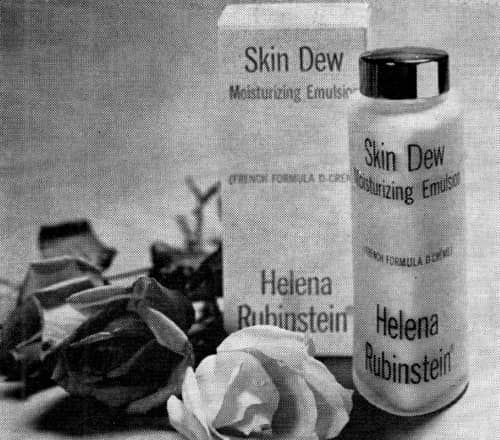
Above: 1956 Skin Dew.
Skin Dew: “[T]he result of years of working with her laboratory chemists and doctors in Paris. … [F]orms an invisible film which protects the inner moisture of deep skin layers and maintains the healthy acid balance of the outer skin. Overnight your skin will look younger, dewier, healthier. A drop of Skin Dew before make-up keeps you glowing all day.”
Supposedly developed in her French laboratory, Skin Dew was described as a greaseless lubricant that could be worn all day under make-up or used at night. The product contained the proprietary ingredient ‘Proteinol’ which formed a ‘wonder film’ that helped the skin retain its essential moisture. Skin Dew also contained ‘fements lactiques’, milk proteins that helped maintain the skin’s acid-alkaline balance, enabling Rubinstein to claim that the produce was mildly antiseptic. She would add collagen to the product in 1964.
In 1957, Rubinstein added Skin Dew Extra-Rich, a night cream formulated with double-strength oils and emollients.
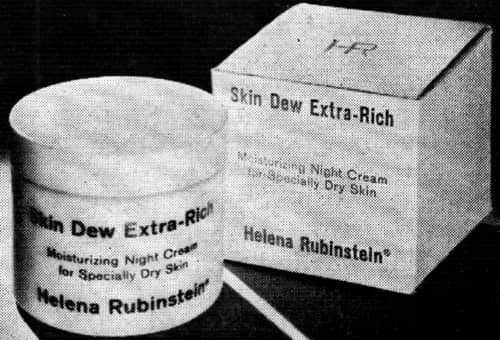
Above: 1957 Skin Dew Extra-Rich.
Rubinstein would go on to stress the moisturising potential of other ‘Dew’ cosmetics including the previously mention Beauty Dew Cleanser (1958) and Dew-Kissed Lipstick (1958) before using the Skin Dew name to create a number of additional products in 1965 – Skin Dew Hand Cream, Skin Dew Cleanser Concentrate and Eye Make-Up Remover, and Skin Dew Freshener and Toner. As its name suggests, Skin Dew Cleanser Concentrate and Eye Make-Up Remover replaced Deep Cleanser for removing eye make-up.
Skin Dew Cleanser Concentrate and Eye Make-Up Remover: “[G]uaranteed to cream away all face make-up. Leaves the skin fresher, immaculately clean.”
Skin Dew Freshener and Toner: “Removes every trace of cleansing cream. An ideal balance of emollient, bacteriostatic and buffering ingredients for protective skin care.”
Skin Dew was one of a number of skin-care products Rubinstein developed in the 1950s and 1960s that were described as greaseless. The use of this term suggests that her cosmetic chemists may have begun using silicones. Other examples of new greaseless, skin-care cosmetics included the previously mentioned Beauty Dew (1958), and Creamessence (1961), a rich night cream.
Tree of Life
In 1957, Rubinstein introduced a number of new skin-care cosmetics in France – Skin Life Cream, Skin Life Mask and Skin Life Honey Tonic – described as providing an ‘inexhaustible source of youth and beauty’, the ‘Tree of Life’. The cosmetics were sold under a variety of names in different parts of the world. For example, when they became available in Britain in 1959 they were initially referred to as Skin Life Turgosomon.
The word Turgosomon is formed from two words—Turgor and Osmos. These terms describe the balance or pressures of vital fluids inside and outside the cells of living tissues such as the action of water in plants. Only when the cells are TURGID—filled with these vital fluids—does the skin look smooth and youthful.
(Helena Rubinstein advertisement, 1961)
In the American market the cosmetics were marketed as Tree of Life Cream and Tree of Life Emulsion (1957) and had the proprietary ingredient ‘Placene’ added to them made from placental extracts. A Tree of Life Lipstick, also containing Placene, was added in 1958 in eight shades.
That beauty may be born again Helena Rubinstein has evolved a rare and potent cream. Tree of Life, whose prime ingredient is Placene Its content: minerals, humectants, lipids, proteins and emollients standing by with their gifts of bloom and softness, smoothness and magnetic moisture.
(Helena Rubinstein advertisement, 1959)
Tree of Life Cream and Tree of Life Emulsion: “Give back to your skin all the beauty of youth! The softness and smoothness, the dewiness, and above all-glowing tone. … It is in Tree of Life that the world’s leading cosmetic authority presents Placene, extrait of human placenta with its revolutionary benefits. In this remarkable cream are historic herbs and a potent oil from a rare tree.”
There does not seem to be any mention of placental extracts in the Tree of Life cosmetics sold in Britain or France. It is possible that the French and British arms of Helena Rubinstein thought that women might not want to apply placental extracts to their skin. They may have been right as American advertisements soon dropped referring to placental material and all mention of Placene seems to have disappeared by the early 1960s.
See also: Placental Creams and Serums
Tree of Life was not the first Rubinstein cosmetic to contain amniotic material. Her chemists in France had previously combined amniotic fluid with blood serum to create Skin Serum, released into the American market in 1953. The amber fluid was packaged in single-use vials which were patted on the face and neck immediately after cleansing. Used every other night, it was said to counteract dryness and hide lines and wrinkles.
Skin Serum: “A biologic beauty treatment that lets your complexion fib about your age. It is not comparable to any beauty preparation you have ever used. You will see an instant tightening, lubrication, bloom of youth.”
Skin Serum appears to have been an early version of the albumin wrinkle smoothers that created so much controversy in the American market in the 1960s.
See also: Albumin Wrinkle Smoothers
Other skin-care cosmetics in the 1957 American Tree of Life range included Royal Honey Mist, Fluid Cleanser, and Circulation Mask. It is likely that Royal Honey Mist and Circulation Mask were American versions of the French Royal Honey Lotion and Skin Life Mask.
Royal Honey Mist: “[A] French formula that combines the most beneficial of all ‘bee’ secrets with unique herbal ingredients to smooth and freshen the complexion, to erase away wrinkles.”
Fluid Cleanser: “[A] Scandinavian formulation of several cleansing oils, each penetrating at different skin levels to root out the many kinds of waste, pore and surface soil. Also guards moisture.”
Circulation Mask: “[A] Viennese created preparation designed to stimulate healthy local circulation of your blood. It works to enliven your complexion, to firm sagging skin. Use it at least twice, weekly.”
The reference to ‘bee secrets’ in the Royal Honey Mist may have been Rubinstein’s rebuke to all the royal jelly cosmetics introduced into the American market in the 1950s. She had decided against adding royal jelly to her skin-care creams preferring instead to combine it with vitamins and proto-gelatin in her Beauty for Life Capsules (1957).
See also: Royal Jelly
Also carrying the Tree of Life logo in the United States in 1957 were two items of make-up, Illumination Foundation and Illumination Face Powder. After Rubinstein’s death in 1965 the company would go on to create a complete line of Illumination make-up and, in 1969, Illumination Mykonos Make-up would become the first Rubinstein globally-released cosmetic line after company’s worldwide consolidation.
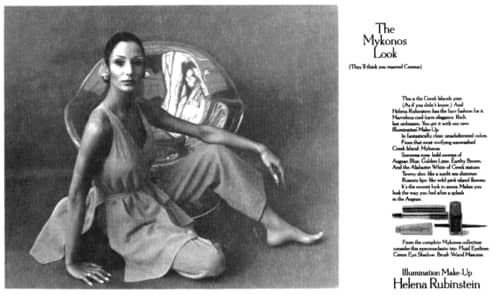
Above: 1969 Illumination Make-up. The Mykonos Look created using makeup selected from: Illumination Cake Eyeliner in Ionian Blue and Alabaster shades; Illumination Fluid Eyeliner in Ionian Blue, Alabaster, Delphic Gray, Earthy Brown and Black Marble shades; Illumination Cake Eyeshadow in Aegean Blue, Golden Lime and Grecian Bronze shades; Illumination Creme Eyeshadow in Alabaster, Aegean Blue, Golden Lime and Grecian Bronze shades; Illumination Eyebrow Brush-on in Soft Brown, Charcoal Brown and Ash Blonde shades; Illumination Brush Wand Mascara in Ionian Blue, Delphic Gray, Earthy Brown and Black Marble shades; and Illumination Lipstick in Sunrise Pink.
Herbessence
In 1961, Rubinstein reorganised the Tree of Life range in the United States so that it became part of the Herbessence Collection, a name Rubinstein had taken from the Herbessence Cream Cleanser introduced the previous year. All references to placental extracts were dropped and the emphasis was now on the healing and beauty-giving power of herbs.
Just as medical science uses the healing property of herbs, the First Lady of Beauty Science, Helena Rubinstein, turns to Euphrasy, Azulene, Calendula, Sweet Birch, and other lovely herbs to use their beauty-giving properties in her HERBESSENCE COLLECTION.
(Rubinstein advertisement 1961)
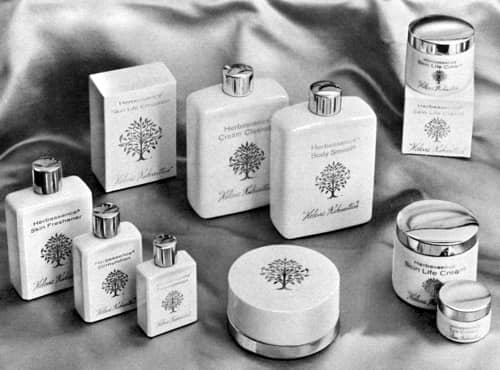
Above: 1961 Herbessence Collection.
The ten products that made up the range were: Herbessence Skin Life Cream, Herbessence Skin Life Emulsion, Herbessence Cream Cleanser, Herbessence Stimulotion, Herbessence Skin Freshener, Herbessence Complexion Soap, Herbessence Eye Cream, Herbessence Eye Pads, Herbessence Body Smooth and Herbessence Beauty Bath. All carried an updated version of the Tree of Life logo as did the accompanying Illumination Foundation and Illumination Face Powder.
Herbessence Skin Life Cream: “[A] unique combination or rare herbals and other ingredients—with our exclusive bio-natural extracts imported from France—and blended in the United States. Helps smooth and soften while you sleep.”
Herbessence Skin Life Emulsion: “Another remarkable blend of rare herbals and other ingredients. This rich moisturizer is instantly absorbed to help beautify all day and to form a perfect foundation for make-up.”
Herbessence Cream Cleanser: “[A] pale green liquid cream with a treasure of rare herbs of acknowledged benefit to beauty. Cleanses deep down.”
Herbessence Stimulotion: “Unique beauty treatment for special occasions. For a radiant younger look that lasts for hours.”
Herbessence Skin Freshener: “Cool, refreshing soothing lotion with herbal ingredients. Protects as it helps counteract dryness.”
Herbessence Complexion Soap: “For the woman who cleanses her face with soap. Extra-creamy, rich foaming.”
Herbessence Eye Cream: “[I]t’s almost instantly absorbed. So invisible you can use it in the daytime with no make-up.”
Exactly why Rubinstein decided to create the Herbessence Collection in the United States is unclear. The cosmetics were sold around the globe but were usually called Skin Life in other parts of the world. One possibility for the differentiation was the declining profit margins in the American market. Elevating the products into a ‘collection’ may have helped Rubinstein charge a premium for the products in the line, thereby improving its profitability.
The Herbessence Collection was not Rubinstein’s first range of herbal cosmetics. In the 1930s, she had had developed a range of ‘herbal’ preparations including: Herbal Mask (1932); Herbal Cleansing Cream and Herbal Muscle Oil (1934); and Herbal Hand Balm, Herbal Eye Tissue Oil, Herbal Skin Tonic and Herbal Hair Remover (1935). After the war she had introduced Herbal Hand Cream and Herbal Hand Lotion (1945); and Herbal Extrait, a toner formulated with camomile, honey, grapes and the juice of water lily buds recommended for Sensitive and Ageing skin types.
Herbal Extrait: “[A] soothing lotion, wonderful to overcome outside dryness and relieve parched skin&rdquo.
Additional products were added to the Herbessence Collection and, by 1965, it also included Herbessence Beauty Bath, Herbessence Eau de Parfum and Herbessence Perfume and Bath Oil, with Herbessence Skin Life Throat Cream and Lotion added in 1966.
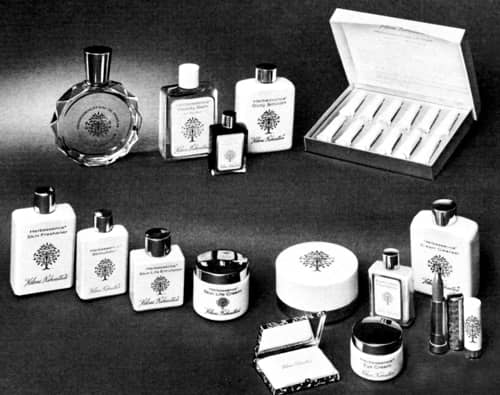
Above: 1965 Herbessence.
Herbessence Skin Life Throat Cream: “[A]n exclusive combination of natural extracts, humectants and emollients that help the throat and neck area lock smoother, softer, firmer.”
Herbessence Skin Life Throat Lotion: “[G]ently astringent. Kelps firm and tighten invisibly.”
Make-up
In 1945, Rubinstein sought to reinvigorate interest in her make-up lines by introducing her most ambitious colour-coordination scheme to date, the Color-Spectrograph. Designed to help women coordinate Helena Rubinstein make-up with their individual colouring, it suggested suitable clothing colours based on hair colour which were then matched to Rubinstein shades of make-up.
WHAT IS A COLOR-SPECTOGRAPH?
It’s a wonderful and personal beauty recipe worked out for blondes, redheads, medium browns, brunettes or silver-greys by Helena Rubinstein, beauty expert and color genius. Your own personal spectrograph will show you what colors you should wear plus the correct make-up for each color.
(Rubinstein advertisement, 1945)
Central to the Color-Spectrograph was lipstick, a make-up item that had become almost essential during the war. Rubinstein packaged different shades of lipsticks into kits of four according to the colours laid out in the Color-Spectrograph. Marketed as Lipstick Wardrobes they were later also known as Lipstick Four-Cast or Color-Keys.
WHAT IS A LIPSTICK WARDROBE?
It’s another magical idea bringing you four full size lipsticks, all with the staying power that has made Rubinstein lipsticks so famous. There’s a special lipstick wardrobe for each color type and all four lipsticks come in a smart cosmetic case with your own Color-Spectograph tucked right into it.(Rubinstein advertisement, 1945)
There were five Lipstick Wardrobes organised according to hair colour – Blonde, Medium-Brown, Redhead, Brunette, and Silver-Gray – each kit coming with its own chart.
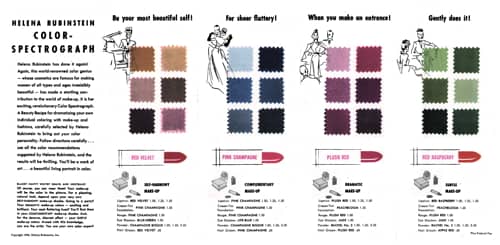
Above: 1945 Medium-Brown Color-Spectrograph Chart that came with the Medium-Brown Lipstick Wardrobe.
Also see the company brochure: Medium brown? (1945)
Each of the four lipsticks in a kit came in its own coloured case – blue, green, yellow and red. To select the perfect lipstick to match her outfit women would choose the case in the colour range of the ensemble they had decided to wear.
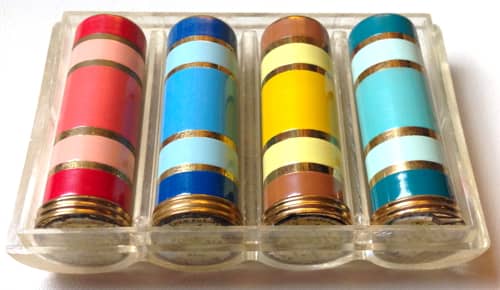
Above: Four-Cast Lipsticks in a lucite container.
Helena Rubinstein’s LIPSTICK FOUR-CAST makes it easy for you to select the right lipstick colors for your own color personality – as well as the right costume colors to express your individuality – this famous color and beauty authority has created especially for your complexion type, your own color-keyed LIPSTICK-FOUR-CAST with the right lipsticks for you to wear with your best costume shades, in costume colored lipstick cases that tell you which lipstick to wear.
(Rubinstein, 1947, pp. 38-39)
Rubinstein persisted with this idea through the 1940s, altering the lipstick ranges as new shades were developed.
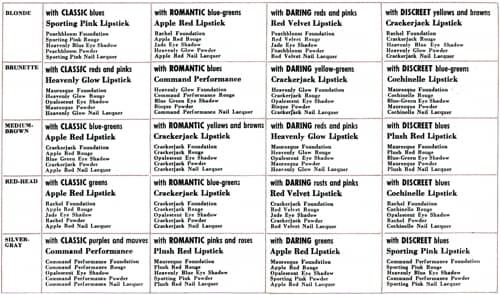
Above: 1947 Colour-coordination chart.
Also see the company booklet: A new and lovelier you (1947)
A weakness of schemes like the Color-Spectrograph was the rapid turnover of fashion colours. This required cosmetic companies to put out new shades of lipstick and nail polish each spring and autumn which made complex colour schemes like the Color-Spectrograph quickly out of date.
See also: Colour Coordination
Foundations and powders
Rubinstein had a number of foundations on the market in 1945 including: Town and Country Make-up Film (1935) in Peachbloom, Mauresque and Suntan shades; Cream-Tint Foundation (1944) in Crackerjack, Heavenly Glow, Command Performance, Peachbloom, Rachel and Mauresque shades; and Medicated Snow Lotion (1945), a modified form of the original Snow Lotion (1908), presumably aimed at younger clients with blemished skin.
Snow Lotion (Medicated): “[A] blessing for broken out skin. It’s a liquid medicated to heal and opaque enough to conceal the blemishes so many people weep over.” Shades: Peachbloom, Mauresque and Suntan.
In 1946, Rubinstein added Milk-Tone, a type of cake make-up made with milk proteins to a patented formula (U.S. Patent No. 2,465,340, 1949). Milk-Tone appears to have superseded the earlier Town and Country Filmpact (1942) and, like the medicated Snow Lotion, was aimed at younger skins. In 1949, it was given a new plastic container with a white base, pink cover and white cut-in lettering.
Milk-Tone: “[T]he only cake make-up containing milk protein, which is very good for adolescent skin problems. It gives you a film of beauty, covers every tiny flaw. Lasts all day.” Shades: Peachblossom, Mauresque, Rachel, and Suntan.
See also: Cake Make-up
Powdered silk
At some stage, the managing director of the British arm of Helena Rubinstein, Boris Forter [1896-1976] secured the rights to a process for producing powdered (atomised) silk. When silk became available once more after the war, powdered silk began to be produced in Rubinstein’s British factory in Surrey, England for export around the world.
See also: Silk Powder
The first two cosmetics Rubinstein made with the powdered silk manufactured in the British factory – Silk-Tone, a semi-liquid foundation and Silk-Film a compressed cream powder – were introduced into the American market in 1948. Silk-Film was recommended for oily skin and Silk-Tone for dry. For older women, Rubinstein later developed Silk-Tone Special (1952) with 6000 IUs of oestrogenic hormones.
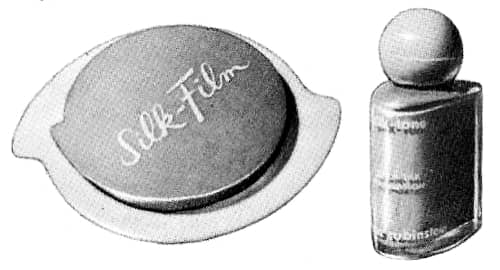
Above: Silk-Film and Silk-Tone foundations. The cosmetics would not arrive in Britain until 1950.
Silk-Film: “[S]ilk-in-cream foundation that glides on quickly, easily, evenly and holds your powder hours longer.” Shades: Peachboom, Rachel, Mauresque, Crackerjack, Rose Beige, and Bronze.
Silk-Tone: “[L]iquid silk foundation, the most gossamer veil of beauty your skin has ever known.” Shades: Peachboom, Rachel, Mauresque, Crackerjack, Rose Beige, and Bronze.
Despite the fact that the manufacturing process had been bought, Rubinstein would later claim that it had been developed in her research laboratory.
About twelve years ago, my research laboratory achieved an exciting step forward in its never-ending quest for perfection in beauty-care. The basis of this new discovery was—silk!
We had long known of the natural properties of silk, which had always been recognized as important to cosmetics. Our new success was to create a face powder based on micronized silk, something never before achieved in cosmetics. The beautifully simple secret of silk is that it contains amino acids, which also form an important part of skin tissue itself. It helps, regulate the skin’s acid-balance and provides the natural conditions for healthy skin growth. Silk and skin, therefore, are natural partners.
Moreover, silk is a natural, tubular resilient fibre, and in its micronized, face powder form, these fibres still retain their tubular structure. Therefore, the powder does not cake, but lets the skin breathe and provides ideal conditions for healthy skin growth. Another blessing of silk is that it is bacterio-static, a valuable property which helps to prevent and clear up minor skin blemishes.
Above all, however, silk face powder clings naturally in a way no mineral substance can, and blends with skin into a silky, translucent glow … a soft, luminous look that is unique to silk.(Rubinstein, 1965, p. 208)
In 1949, Rubinstein began selling Silk-Screen Face Powder and Silk Compact Powder in the United States. Silk Screen Face Powder – called Silk Face Powder in some parts of the world – came in two versions, one for normal skin and one for dry, an idea that extends back to the Rubinstein’s earlier Valaze Complexion Powder and Novena Poudre.
Silk-Screen Face Powder: “[U]nlike any other you have ever used, because it is blended with pure silk, processed, pulverised and milled with the finest powder. It is so light it feels like a delicate veil of silk on your skin . . . and it clings lightly but with the tenacity of silk.” Shades: Peachbloom, Rachel, Rose Mauve, Mauresque, Command Performance, Crackerjack, Bisque, and Bronze.
With the addition of Silk-Tone Special with oestrogen hormones in 1952, Rubinstein’s recommended foundation for each skin type were then: Dry – Silk-Tone; Mature – Silk-Tone Special; Oily – Milk-Tone; Sensitive – Silk-Film; Young – Milk-Tone; and Blemished – Snow Lotion (medicated). Women with a Normal skin type could chose the foundation that they thought suited them best.
In 1955, Rubinstein introduced English Complexion Powder and English Complexion Compact Powder into the American market. They were made with a higher proportion of atomised silk than Silk-Screen Powder but still used the micronised (atomised) silk imported from the Rubinstein factory in Surrey.

Above: 1955 Helena Rubinstein English Complexion Powder and English Complexion Compact Powder.
Helena Rubinstein imports pure “atomized” silk from England to be compounded into this superb powder, Its light, airy texture imparts a luminous quality to the akin, giving It the subtle beauty for which British complexions have long been famed.
(Rubinstein advertisement, 1956)
English Complexion Powder and Compact only came in Peachbloom, Mauresque, Beige Glow, Crackerjack, Rose Mauve, and Bronze shades and – going on the number of images of royalty used in its advertising – appears to have been a belated attempt by Rubinstein to capitalise on the American interest in Queen Elizabeth generated by her coronation in June, 1953.
See also: Coronation Cosmetics
In 1953, Rubinstein also introduced Minute Make-up, a powder-cream foundation and powder in one containing powdered slik and lanolin. Packaged in a pink and gold plastic compact, Rubinstein suggested it could be used when making up on the run or touching up during the day. In 1954, a new shade, Beige Glow, was added and the make-up became available in black compacts as well as pink.
Minute Make-up: “[C]ompounded of creamy base and silken powder—plus lanolin. This new and better formula erases skin shadows, covers every tiny line and flaw with a soft, pearly smooth finish.” Shades: Peachbloom, Rachel, Crackerjack, Rose Beige, Mauresque, and Bronze.
Silk Fashion
In the early 1960s, slim-line or pencil lipsticks became fashionable once again and a number of companies made them with Helena Rubinstein being one of the earliest. Fashion Stick (1962) was oval in cross-section so that it could act as a lipstick and lip liner on one.
In 1963, Rubinstein introduced Silk Fashion Liquid Make-up in eight shades made with ‘English-processed silk for extra cling’. Silk Fashion Liquid Make-up was combined with Silk Fashion Compact Powder and the previously mentioned Fashion Stick Lipstick to begin the Silk Fashion range. This would replace the earlier Silken Look cosmetics started with the introduction of Silk-Film and Silk-Tone in 1947.
Silk Fashion Liquid Make-up: “[A] moisturizing liquid make-up is created to accent the soft curve of your cheek . . . the deepness of your eyes . . . your loveliest contours.”
Lipstick and rouge
Rubinstein already made both cream and powdered rouges – which, by the 1950s, were simply referred to as Creme Rouge and Powdered Rouge – but, in 1952, the company added Silk-Tone Liquid Rouge made with powdered silk.
Silk-Tone Liquid Rouge: “[G]ives you the most natural blush, the most youthful glow you have ever seen. Smooths on so easily anyone can apply it like an expert.” Shades: Pink-Tone, Coral-Tone, and Red-Tone, with Rose-Tone added in 1955.
Two years earlier, in 1950, Rubinstein had also created a new silk lipstick.
Silken Lipstick: “It is a brighter, smoother, richer-colored lipstick because its sensational new formula contains silk, atomized. This silk does exciting things for you—it gives your mouth the luscious sheen of very young lips. Never smears, but keeps a crisp, clean curve.” Shades: Orange Fire, Crackerjack, Copper Leaf, Apple Red, Red Raspberry, Red Velvet, Tender Pink, Sporting Pink, Plush Red, Electric Pink, Rose Mauve, and Command Performance.
Unfortunately for Rubinstein, the American lipstick market underwent a dramatic change in 1950 when Hazel Bishop’s indelible Long Lasting Lipstick, quickly renamed No-Smear Lipstick began what is known as the ‘Lipstick Wars’ in the United States. The main players were Hazel Bishop, Revlon and Coty but Rubinstein also got caught up in it.
See also: Lipstick Wars and Indelible Lipsticks
Rubinstein had been selling indelible lipsticks ever since her first Valaze Lipstick (1925) but now felt it necessary to get her chemists to formulate a new one. In 1951, she released Stay-Long in a refillable lipstick case containing the proprietary ingredient ‘Indelibase’.
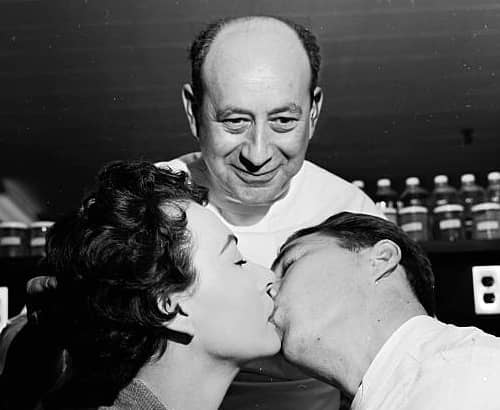
Above: 1950 Publicity shot of Dr. Julius Wetterhahn [1901-1991], chief chemist at the Rubinstein plant in Long Island, with subjects ‘testing’ a new indelible lipstick.
Stay-Long Lipstick: Here is the first indelible lipstick which is truly creamy! … [It] not only stays on till you remove it, but also protects your lips against drying. It contains a revolutionary new ingredient, “Indelibase,” which stops it from coming off on cigarettes, cups or babies. Shades: Red Velvet, Apple Red, Orange Fire, Tender Pink, Crackerjack, Red Raspberry, Sporting Pink, Plush Red, Rose Mauve, and Red Hellion with Lively Talk, and Bright Saying added by the end of the year.
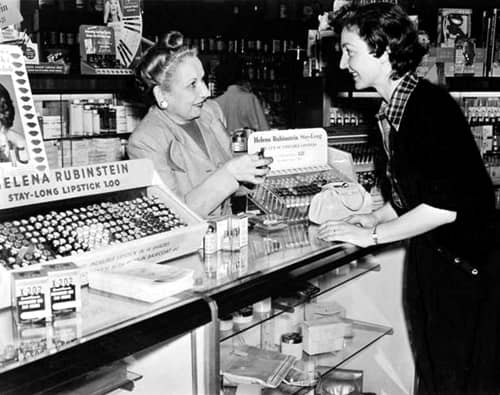
Above: c.1951 Helena Rubinstein counter in the United States with Stay-Long Lipsticks.
Rubinstein continued to add other new lipsticks during the 1950s to shore up her small share of the American lipstick market which, by 1956, only amounted to 1% compared with Revlon’s 26%. These included: Stay-Lustre (1952), a semi-indelible; Young Look with ‘Medilene’ and Waterproof with ‘Nutrisol’ (1956); Stay-Moist (1957); Dew-Kissed (1958); and Heart Shaped lipsticks (1959).
Stay-Lustre Lipstick: “[E]xtra rich and creamy it moisturises and protects dry lips. Keeps them soft and smooth as satin … keeps color perfect when you eat, drink or kiss.”
Young Look Lipstick: “The full, rich color holds until it’s time to renew the beauty treatment your lips should have. … [I]s non-smear, non-runny–nothing like those old-fashioned lipsticks you used to know.”
Waterproof Lipstick: “[A]mazing new long-lasting formula, you can swim, drink, wet your lips—it won’t smear or disappear.”
Stay-Moist Lipstick: “[S]cientifically treats lip tissue, helps heal, guards against cracking. This great new moisturizing lipstick also gives a clean outline, is never greasy. And it feels so comfortable.”
Dew-Kissed Lipstick: “[R]eleases fresh moisture to the lips every moment you wear it! No more chapped lips. No more dull, dry lips. No more licking your lips to make them feel more comfortable.”
The Young Look Lipstick appears to have been renamed as Young Lustre in 1957. It is possible that Rubinstein did this after getting a complaint from Lehn & Fink who started direct-selling their Young Look line of cosmetics around this time.
See also: Lehn & Fink
Trying to keep up with companies like Revlon, Rubinstein also added a number of new shades into the American market in the 1950s including: Pink Beauty, Dark Red, and Orange Fire (1950); Lively Talk, and Bright Saying (1951); Sunny Coral, and Pink and Fair (1952); Gauguin Pink, and Copper Leaf (1953); Wear With All Red (1954); Torero Pink, and Jazz (1955); Italian Pink, and Playing With Fire (1957); 24-Karat Red, Bed of Roses, and Ripe Orange (1958); and Hot Red, Fashion Pink, Plum Wild, and Amber Rose (1959). There were also specific shades created for individual lipstick lines. For example, Waterproof Lipsticks were introduced in True Red, True Coral, True Pink and True Blue Red and Heart Shaped Lipsticks debuted in Heart of Pink, Heart of Red, Heart of Coral, Heart of Cherry, and Heart of Peach shades.
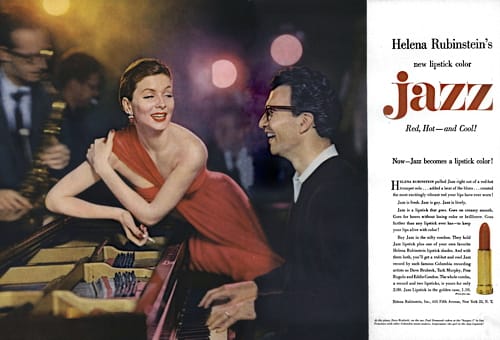
Above: 1955 Helena Rubinstein Jazz.
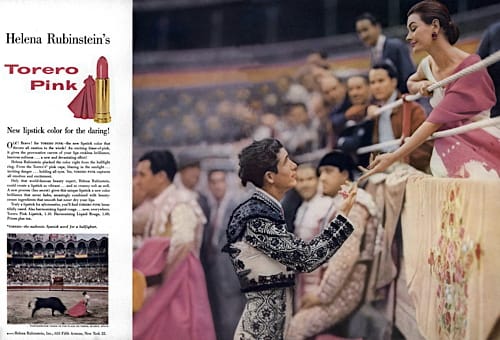
Above: 1955 Helena Rubinstein Torero Pink.
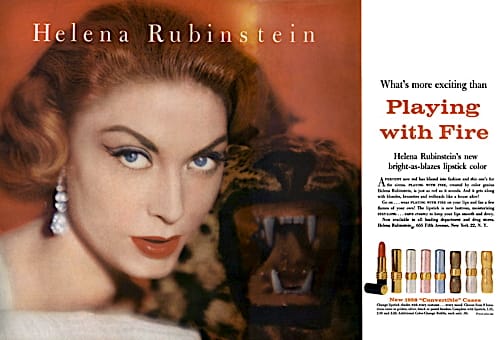
Above: 1957 Helena Rubinstein Playing With Fire.
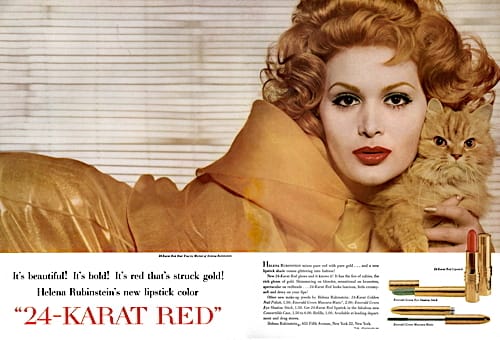
Above: 1958 Helena Rubinstein 24-Karat Red.
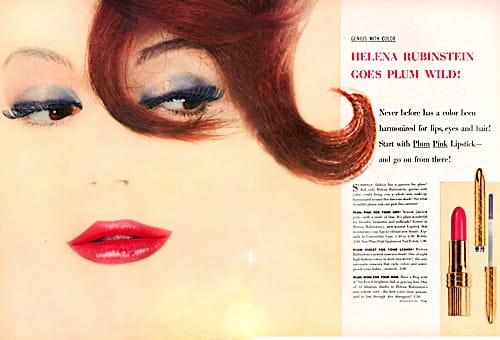
Above: 1959 Helena Rubinstein Plum Wild.
The company also added a number of lipstick cases during the 1950s including: Jewel Top cases (1952) with simulated ruby, emerald, sapphire, turquoise, topaz or coral stone tops.
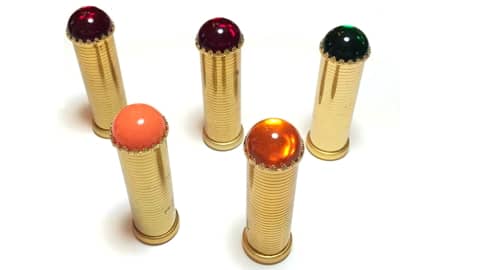
Above: Helena Rubinstein Stay Log Lipsticks in Jewel Top cases.
Her glamorous Convertible Cases released in 1957 were similar to the Futurama cases launched by Revlon in 1955 that were also refilled with cartridges. Rubinstein colluded with Revlon and others to fix the price of the cartridge refills.

Above: Helena Rubinstein Convertible lipstick cases.
Hands and nails
Colour campaigns of the 1940s and 1950s, run by Revlon and others, matched lipstick with nail polish. Women who bought a nail lacquer, enamel or polish from a cosmetic company were more likely to buy a matching lipstick from that company as well, something Revlon was well aware of when it started its ‘matching fingertips and lips’ campaign in 1940.
Rubinstein’s Nail Groom nail polishes were not popular and this must have affected the sale of her lipsticks. She made a number of attempts to improved their formulation introducing a new range of polishes called Nail Lacquers in 1946. These were replaced by Stay-Long Nail Polish matched to her Stay-Long lipsticks in 1951. Neither line became best sellers.
Rubinstein also updated her hand creams and lotions, adding Herbal Hand Cream and Herbal Hand Lotion in 1945. Hand creams had become more important to women during the war as women took up factory work so these new hand preparations were latecomers.
Hand Treatment Duo: “Winter-roughened hands need Helena Rubinstein’s protective hand care. Massage hands daily with velvety Herbal Hand Lotion. At night apply Herbal Hand Cream for a welcome whitening effect.”
See also: Hand Balms, Creams & Lotions and Barrier Creams & Lotions
As mentioned earlier, Rubinstein then went on to create Estrogenic Hormone Hand Lotion (1948) containing 16000 IUs of oestrogens, followed by Young Touch Hand Lotion (1957). Other hand cosmetics added during this period included Silk Velvet Hand Lotion (1950), Hand Bleach Cream (1951), and Hand Delight (1953).
Eye cosmetics
There was almost no change in Rubinstein’s eye make-up in the years immediately after 1945 with most promotions going to the Waterproof Mascara she introduced in 1939. This was based on a patented formular devised by the ‘Mascara Countess’, Helene Vierthaler Winterstein [1900-1966], that Rubinstein used under license.
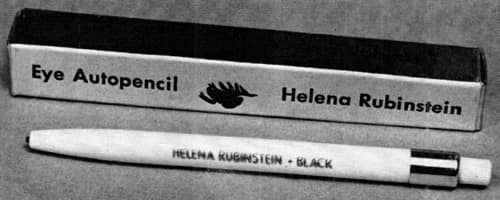
Above: 1951 Helena Rubinstein Eye Autopencil. Shades: Black, Brown, Blue, and Green.
In 1951, the company added Eye Autopencil, an automatic, refillable eyebrow pencil to be used with Waterproof Mascara and Luminous Eye Shadow. In 1954, Rubinstein then added Eye Shadow Stick in a slim, golden metal swivel container in Jade, French Blue, Blue, Blue-Green, Opalescent, and Platinum shades.
In 1957, Rubinstein introduced a cosmetic that was to have widespread ramifications in the beauty industry. Called the Mascara-matic it used a new method for applying mascara – a wand rather than a brush with early advertisements by Rubinstein describing it as ‘brushless’. The slim, gold-coloured device – which may have been manufactured by the German company Schmidt & Niedermeier – was filled with Rubinstein’s Waterproof Mascara.
Mascara-matic: “[C]urls, colors and waterproofs lashes instantly. … Because Mascara-matic contains Helena Rubinstein’s waterproof mascara, it won’t run or smear.” Shades: Black, Brown and Blue with Dark-Green added later in the year.
The idea of a wand mascara was widely copied by other cosmetic manufacturers and its adoption led to the almost total demise of the previously popular cake mascara.
See also: Automatic Mascara
In 1963, Rubinstein added Long-Lash Mascara enriched with silk fibres which added length and thickness as it coloured the lashes.
Long-Lash Mascara: “With Long-Lash Mascara your lashes don’t just look longer . . . they actually are longer. So long . . . so lush . . . so absolutely sweeping . . . you won’t believe your eyes! Yet your lashes are silky soft, completely natural-looking.” Shades: Black, Brown, and Navy-Blue.
Long-lash still used the grooved applicator used in the original Mascara-matic but the company would switch to a brush-wand by 1969.
Youth market
In 1961, Noxzema launched its Cover Girl brand of make-up medicated with hexachlorophene into the American market. Its success saw a number of cosmetic companies produce similar lines of medicated make-up for the youth market. Helena Rubinstein’s version was Clear and Lovely Liquid Make-up, and Clear and Lovely Compact Make-up, both in seven shades (1961). The company added Clear and Lovely Medicated Blush in four shades in 1965, and Clear and Lovely Matte Make-up in a tube in seven shades in 1966.
Clear and Lovely: “[G]ives natural beauty to young startlets … [A] non-greasy, liquid make-up formula that helps heal as it beautifies your complexion. … [A]lso comes in an exclusive ivory oval compact for your purse, with the only puff specially treated to stay effectively antiseptic throughout its use.”
Clear and Lovely Matte Make-up may have been a medicated version of Coverfluid, a matte make-up also sold in a tube that Rubinstein had introduced in 1961.
Coverfluid: “[A] new moisturising French formula make-up. Results in a translucent matt finish that gives a soft, natural look to the complexion and can be worn without matching face powder.”
In 1967, the company added Lightworks, a make-up range aimed at the teenage market packaged in distinctive white containers with black polka dots.
Transition and consolidation
Helena Rubinstein died in April, 1965 and her death was one of a number of changes the company had to grapple with during the 1960s.
In 1960, Helena Rubinstein, Inc. consisted of the American corporation and its subsidiaries in Canada Venezuela, and Brazil. In the Americas there was also Helena Rubinstein of Argentina SA, a corporation based in Delaware but operating in Argentina. Sales in the Americas rose between 1960 and 1965 but all was not well. The company’s reported Consolidated Net Income – which included the Canadian, Venezuelan and Brazilian businesses – rose from US$1,704,905 in 1960 to US$1,801,737 in 1965 but the 1965 statement also included US$465,054 from Argentina SA for the first time which means that Net Income actually fell. The weakness was in the United States. It was still the largest market for Helena Rubinstein but the rising cost of doing business there meant that profit margins were low. By 1969, reported income from the United States was behind Latin America and Continental Europe.
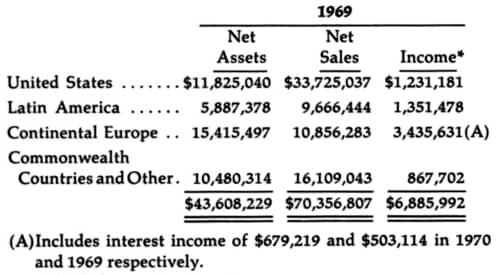
Above: Helena Rubinstein incomes (Helena Rubinstein annual report, 1970). Sales are much larger in the United States than elsewhere but the Latin American and European businesses seem to have better margins.
After Rubinstein’s demise in 1965, the American business went through a period of transition. It reorganised its merchandising and marketing divisions, increased its research and development programs, moved its offices to the General Motors Building in New York City in 1969, increased its manufacturing capacity in Central and South America, and appointed Lehman Brothers as financial advisors to the corporation with Arthur D. Schulte, a general partner of Lehman Brothers, elected to the board in 1967.

Above: Helena Rubinstein reception in the General Motors Building with Dali’s surrealistic portrait of Helena Rubinstein on the wall.
Another important appointment made during this time was Edwin W. Hamowy who became vice-president of Foreign Operations and then company president and chief operating officer in 1970. It would appear that it was Hamowy who was responsible for consolidating the worldwide operations of Helena Rubinstein in 1969 which combined the private companies operating in the United Kingdom, Europe, Asia, Africa, Australia and New Zealand with the American businesses into a single international organisation. As part of the process of consolidation the company also began to buy up its European distributors starting with West Germany.
In 1972, the company recorded its first loss in the American market. By this time the board was actively looking for a new owner and, in 1973, Helena Rubinstein was sold to Colgate-Palmolive for just over US$143 million.
Colgate-Palmolive elected to keep Helena Rubinstein in department stores rather than move it to higher-volume drug stores but marketing failures and adverse economic conditions saw Helena Rubinstein continue to incur a series of losses. In 1980, Colgate-Palmolive became desperate enough to sell the Rubinstein business to Albi Enterprises, Inc. – a privately-owned concern established by Alvin Burack, a longtime cosmetics industry executive, and William Weiss, a New York lawyer – for a mere US$20 million. Albi subsequently withdrew Helena Rubinstein from the American market in 1983.
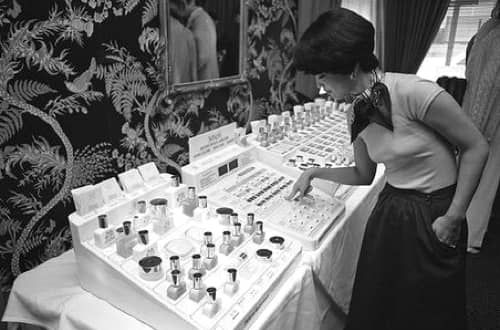
Above: 1977 The Helena Rubinstein Skin Life Colorscope. One of a number of marketing failures initiated by Colgate-Palmolive.
The company is currently owned by L’Oreal who completed their purchase of Helena Rubinstein in 1988.
Timeline
| 1945 | New Products: Snow Lotion (Medicated); Herbal Hand Cream (night) and Herbal Hand Lotion (day); and Estrogenic Hormone Cream and Estrogenic Hormone Oil. |
| 1946 | Perfume factory established in Grasse. New Products: Plus Cleanser; Milk-Tone Cake Make-up; Nail Lacquer; and Turret Stirling Silver Lipstick Case. |
| 1948 | New York salon and executive offices moved to 655 Fifth Avenue. Helena Rubinstein (Eire) founded. New Products: Estrogenic Hormone Hand Lotion; Estrolar Throat Oil; and Silk-Tone and Silk-Film Foundations. |
| 1949 | New Products: Nudit; Silk Screen Face Powder and Compact Powder. |
| 1950 | New Products: Silken Lipstick; Silk Velvet Hand Lotion; Sun and Windproof Lotion; and Dandruff Control Lotion. |
| 1951 | London Salon moves to 3 Grafton Street. New Products: Perfume Spray Deodorant; Deodorant Soap; Stay-Long Lipstick; Stay-Long Nail Polish; Deep Cleanser; Eye Autopencil; and Hand Bleach Cream. |
| 1952 | New Washington salon opened. New American factory opened at East Hills, Long Island. New Products: Silk-Tone Special with hormones; Contour Lift Film; Stay-lustre Lipstick; and Silk-Tone Liquid Rouge. |
| 1953 | New Products: Perfume Deodorant Stick; Skin Serum; Lanolin-Vitamin Formula; Hand Delight; and Minute Make-up. |
| 1954 | New factories opened in California and Etobicoke, Canada. Gourielli Men’s Shop opened at 55th Street, New York. New Products: Hair Stick; Nudit Special; Perfumed Deodorant Pads; Suntan Spray; Tan-In-A-minute; Sun and Sport Liquid Cream; Everpoint Eye Pencil; and Eye Shadow Stick. |
| 1955 | New Products: English Complexion Powder and English Complexion Compact Powder become available in the USA. |
| 1956 | Gourielli Men’s Shop closed. New Products: Skin Dew available in the USA; Medicated Beauty Treatment; Sportswear Cream; and Young Look Lipstick. |
| 1957 | New Products: Mascara-matic; Eye Shadow Stick; Convertible Lipstick Cases; Stay-Moist Lipstick; Illumination Foundation and Face Powder; Tree of Life range; Estrogenic Hormone Cream with Progesterone; Skin Dew Extra-Rich; B-Dry; and Beauty for Life capsules. |
| 1958 | New Products: Beauty Dew; Tree of Life Lipstick; Heavenly Glow Compact; Ultra-Matic; Dew-Kissed Lipstick; and Young Touch Hand Lotion. |
| 1959 | New Products: Ultra Feminine Face Cream. |
| 1960 | New Products: Tree of Life Beauty Bath for Dry Skin; Herbessence Cream Cleanser; Biodorant; Bio-Cleanser and Bio-Clear Medicated X Cream. |
| 1961 | Little Theatre school opens in the New York Salon. New Products: Tree of Life Beauty Bath Oil; Creamessence; Herbessence Collection; Coverfluid; and Clear and Lovely Liquid and Compact Make-up. |
| 1962 | Factory opened in Tel Aviv, Israel. New Products: Bikini Suntan Lotion; and Fashion Stick lipstick. |
| 1963 | New Products: Long-Lash Mascara; and Silk Fashion Liquid Make-up. |
| 1965 | New Factory in Guatemala City, Guatemala. New Products: Clear and Lovely Medicated Blush; Fashion Matte Eye Shadow; Natural Blush; Telescoping Brush; and Strong and Long nail hardener. |
| 1966 | Lease at 655 Fifth Avenue, New York sold. New Products: Herbessence Skin Life Throat Cream and Lotion; Clear and Lovely Medicated Matte Make-up; and Beauty Sun Cream. |
| 1967 | Acquires Mexican distributer, Cullen S.A. New Products: Lightworks make-up range. |
| 1968 | New York offices moved to 767 Fifth Avenue, New York. New Products: Silk Fashion Minute Make-up; Pat-A-Glow electro-vibrator; Silk Leg and Body Make-up; and Beautylift. |
| 1969 | Worldwide operations of Helena Rubinstein consolidated. New factory in Gotemba, Japan. New Products: Mykonos Illumination Make-up; Le Lipstick; and Silk Make-up Stick. |
| 1970 | New Products: Automatic Minute Eyeliner; Silk Fashion Glowstick; and Skin Balance. |
| 1973 | Helena Rubinstein sold to Colgate-Palmolive. |
| 1980 | Colgate-Palmolive sells Helena Rubinstein to Albi Enterprises, Inc. |
| 1984 | L’Oréal buys Helena Rubinstein in Latin America and Japan. |
| 1988 | L’Oréal acquires worldwide assets of Helena Rubinstein. |
First Posted: 18th September 2017
Last Update: 17th April 2023
Sources
Abrams, G. J. (1977). That man: The story of Charles Revson. New York: Manor Books, Inc.
Allen, M. (1981). Selling dreams: Inside the beauty business. London: J. M. Dent & Sons Ltd.
Broadcasting telecasting. (1956). Washington, DC: Broadcasting Publications, Inc.
Fabe, M. (1972). Beauty millionaire. The life of Helena Rubinstein. New York: Thomas Y. Crowell Company.
Face it boys. (1954). LIFE, December 14, 63-64, 67.
Helena Rubinstein. (1947). A new and lovelier you [Booklet]. USA: Author.
Helena Rubinstein. (c.1949). Wonder Course [Booklets]. USA: Author.
Helena Rubinstein. (c.1952). Beauty for you: Every woman’s ABC of skin care hair care and make-up [Booklet]. Sydney: Author.
Helena Rubinstein. (1954). How to solve your beauty problems [Booklet]. Ontario: Author.
Helena Rubinstein. (1969). Your guide to the beautiful life with Herbessence preparations [Booklet]. USA: Author.
Helena Rubinstein, Inc. Annual Reports 1961-1970.
Jones, G. (2010). Beauty imagined: A history of the global beauty industry. Oxford: Oxford University Press.
O’Higgins, P. (1971). Madame: An intimate biography of Helena Rubinstein. New York: The Viking Press.
Rubinstein, H. (1965). My life for beauty. Sydney: The Bodley Head Ltd.
Slesin, S. (2003). Over the top: Helena Rubinstein extraordinary style, beauty, art, fashion design. New York: Pointed Leaf Press.
Woodhead, L. (2003). War paint. Miss Elizabeth Arden and madame Helena Rubinstein their lives, their times, their rivalry. London: Virago Press.
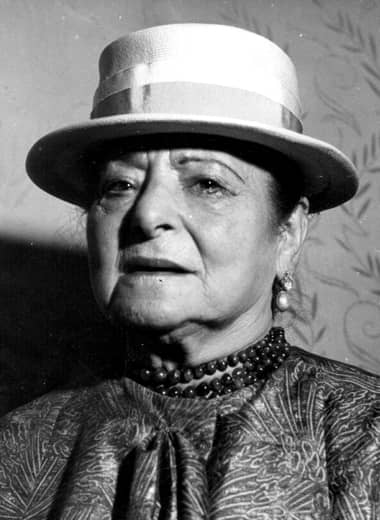
Helena Rubinstein [1871-1965].
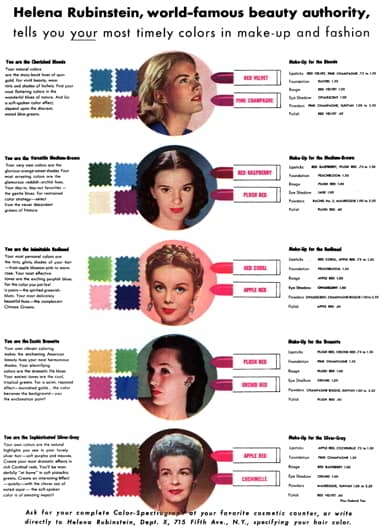
1945 Helena Rubinstein Color-Spectrograph.
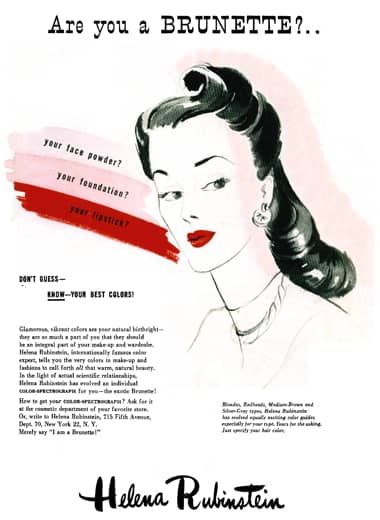
1945 Helena Rubinstein Brunette Color-Spectrograph.

1945 Helena Rubinstein Heaven-Sent, Apple Blossom and White flame perfumes.
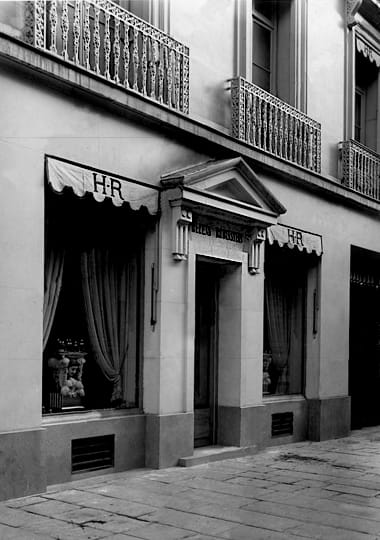
1945 Helena Rubinstein Paris salon on the Rue du Faubourg.
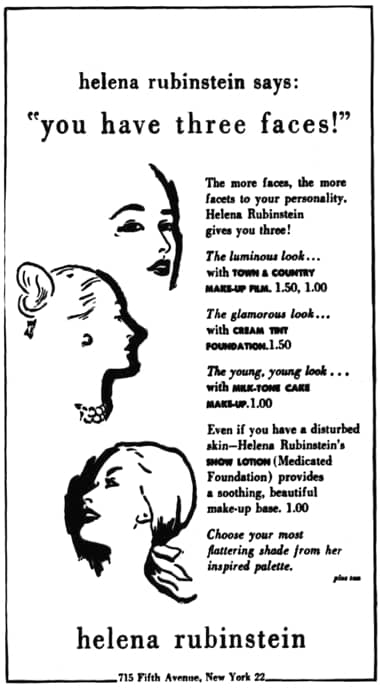
1946 Helena Rubinstein Town and Country Make-up film, Milk-Tone Cake Make-up, and Snow Lotion (Medicated Foundation).
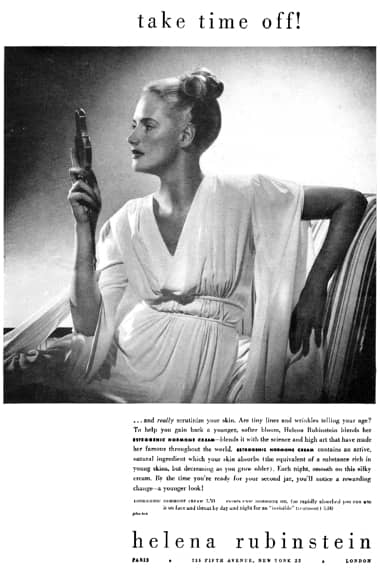
1947 Helena Rubinstein Estrogenic Hormone Cream and Estrogenic Hormone Oil (France).
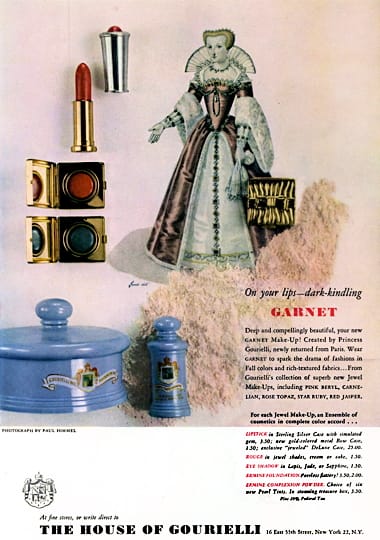
1947 Helena Rubinstein House of Gourielli.
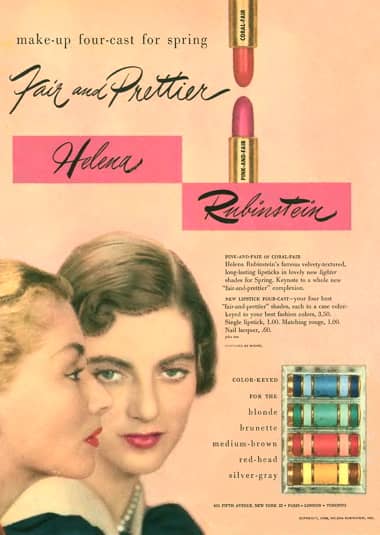
1948 Helena Rubinstein Four-Cast Lipsticks.
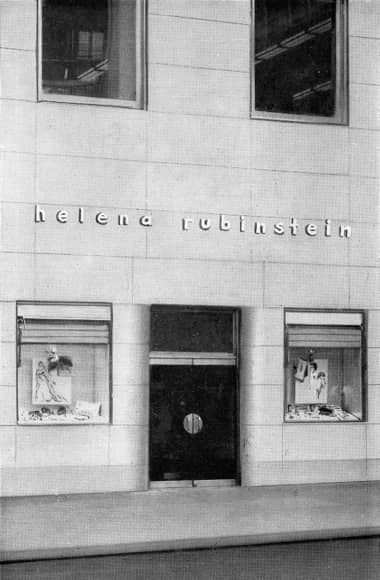
Entrance to the Helena Rubinstein salon at 655 Fifth Avenue, New York opened in 1948.
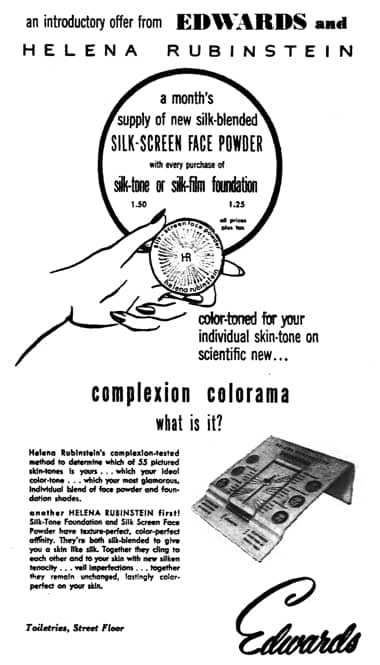
1949 Helena Rubinstein Colorama.
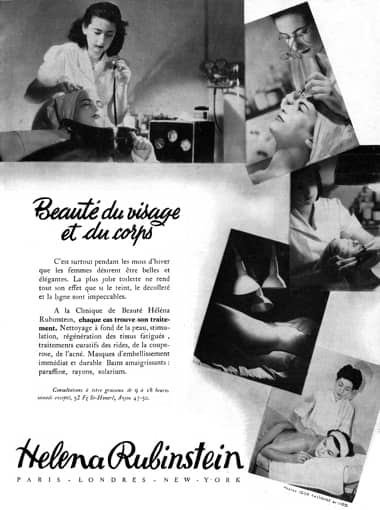
1949 Helena Rubinstein Salon Treatments for face and body (France).
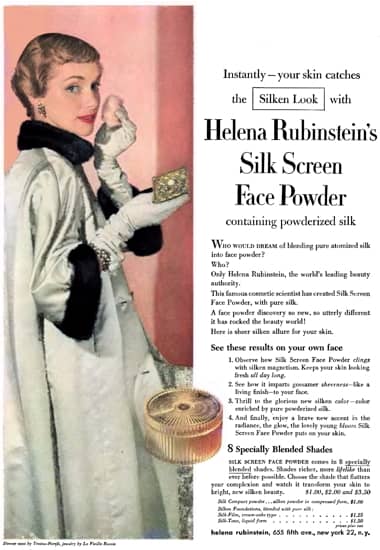
1949 Helena Rubinstein Silk Screen Face Powder.
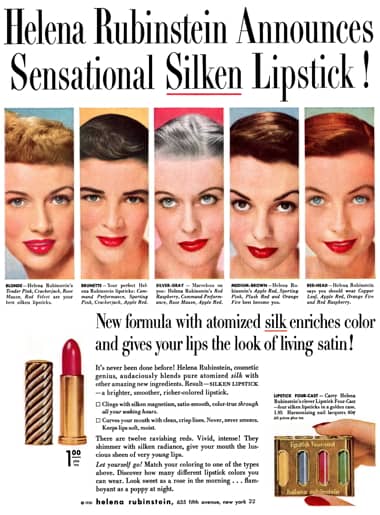
1950 Helena Rubinstein Silken Lipstick.
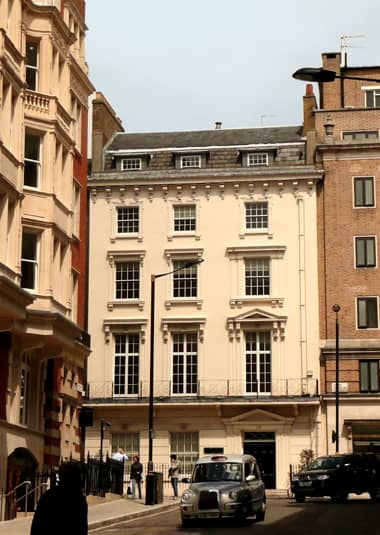
Building at 3 Grafton Street after it was no longer the site of Helena Rubinstein’s London salon.
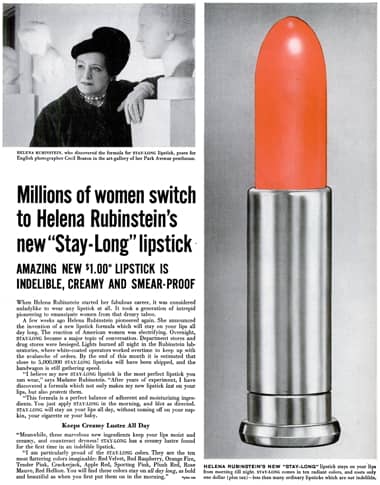
1951 Helena Rubinstein Stay-Long Lipstick.

1951 Helena Rubinstein Stay-Long Lipstick and Nail Polish in matching shades.

1951 Helena Rubinstein Silk-Tone, Milk-Tone, Silk-Film and Snow Lotion.

1951 Helena Rubinstein – solve your beauty problems.
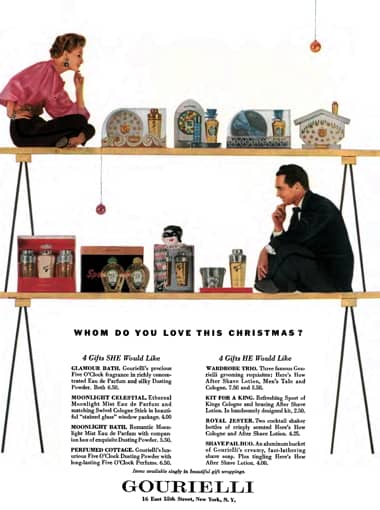
1952 Helena Rubinstein Gourielli.
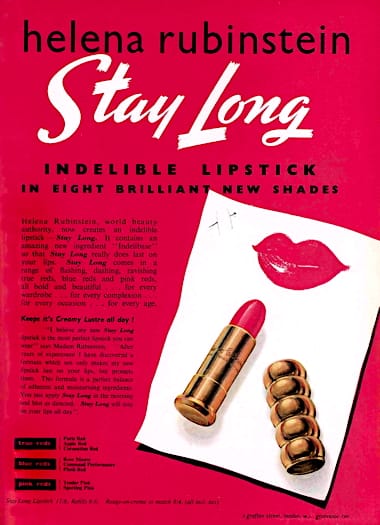
1952 Helena Rubinstein Stay Long Lipsticks (Britain).
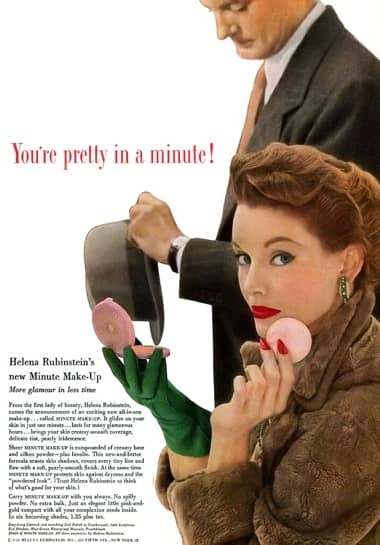
1953 Helena Rubinstein Minute Make-up. Rubinstein had used the ‘Minute’ idea before in Minute Make-up Pads (1939) and Minute Stocking Film (1944).
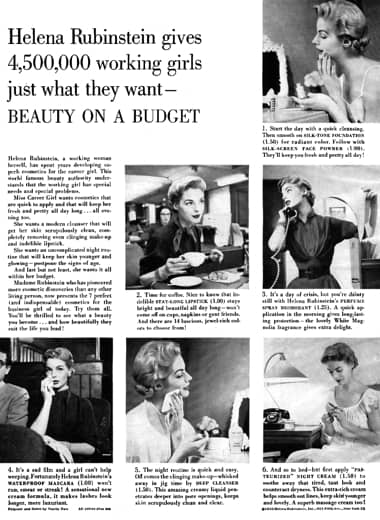
1953 Helena Rubinstein Beauty on a Budget.
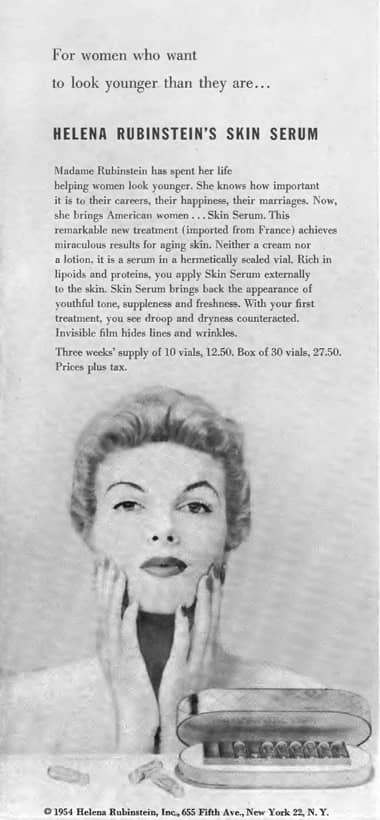
1954 Helena Rubinstein Skin Serum.
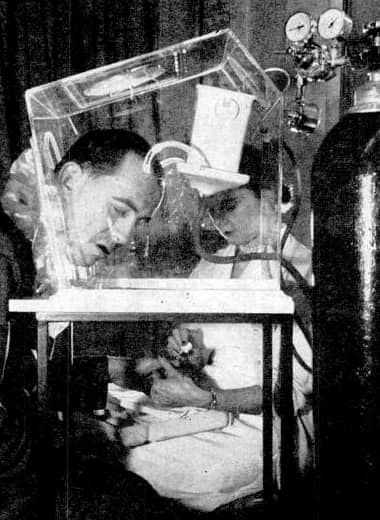
1954 Man taking a hangover treatment in the Gourielli establishment while he gets a manicure (LIFE). I assume the gas being dispensed into the tank contains higher levels of oxygen.
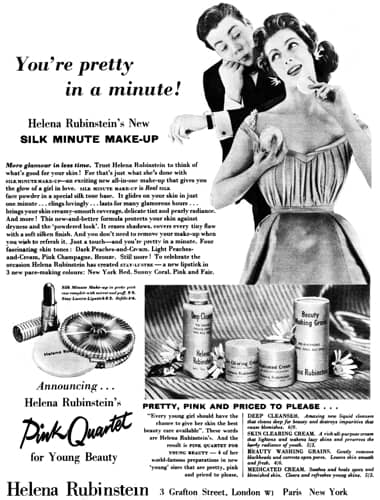
1954 Helena Rubinstein Minute Make-up.
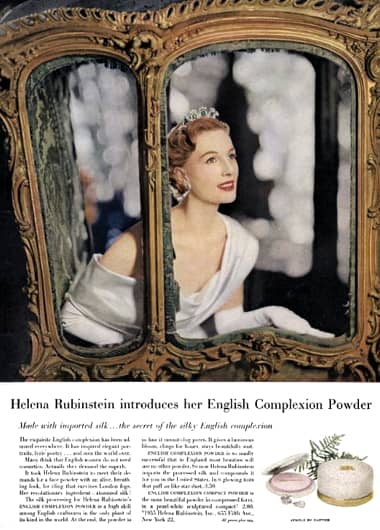
1955 Helena Rubinstein English Complexion Powder and English Complexion Compact Powder.

1955 Helena Rubinstein hormone treatments.

1955 Helena Rubinstein eye cosmetics.
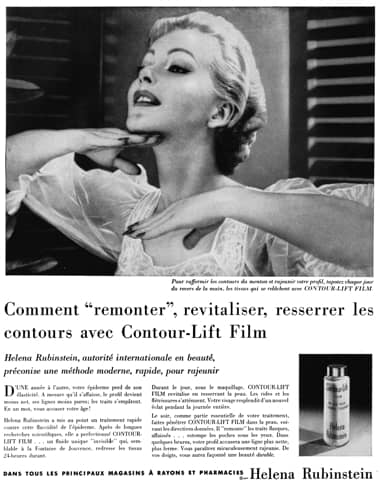
1956 Helena Rubinstein Contour-Lift Film (France).

1956 Mala Rubinstein [1905-1999] demonstrating the use of a mosturizing facial mask in Joske’s department store in San Antonio, Texas. A small fee helped cover the cost of the Beauty Box of Rubinstein products given to each participant.
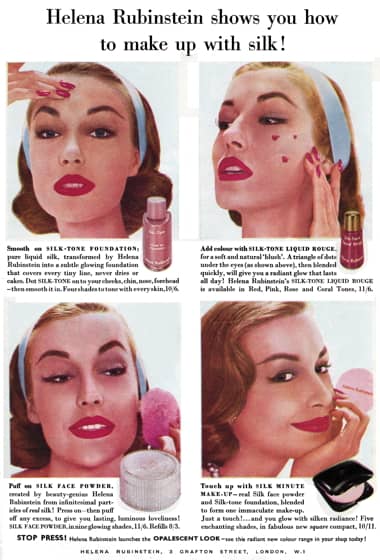
1957 Helena Rubinstein Silk-Tone Foundation, Silk-Tone Liquid Rouge, Silk Face Powder and Minute Make-up (Britain).

1957 Helena Rubinstein Color-Tone Shampoo.
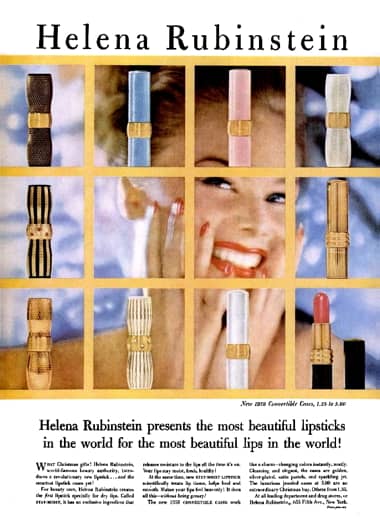
1957 Helena Rubinstein convertible lipstick cases with Stay-Moist lipstick. Top row: Black and gold mesh; Satiny blue and golden; Satiny pink and golden; and Golden-meshed silver plate. Middle row: “Rubies” and “gold” striped with black; and Golden columns. Bottom row: Golden mesh; “Diamonds” and “silver” with golden stripes; Spun silver plate, golden ringed; and Golden ringed on black.
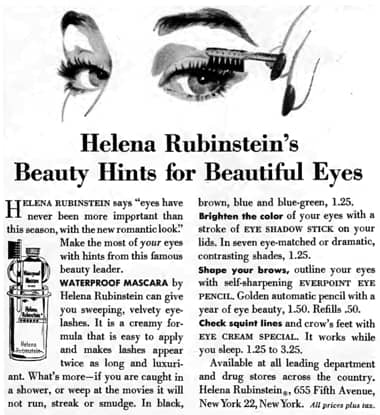
1957 Helena Rubinstein Waterproof Mascara.
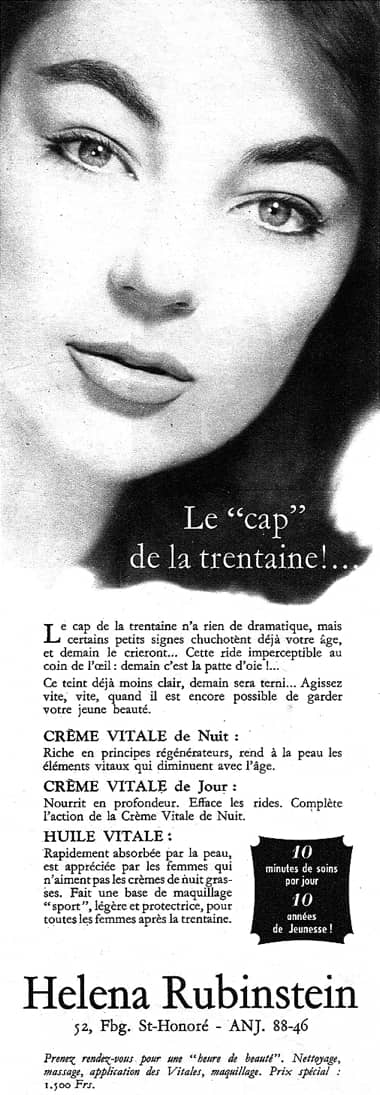
1957 Helena Rubinstein Crème Vital de Nuit, Crème Vital de Jour, and Huile Vital. These French cosmetics may have been the inspiration for Skin Life.
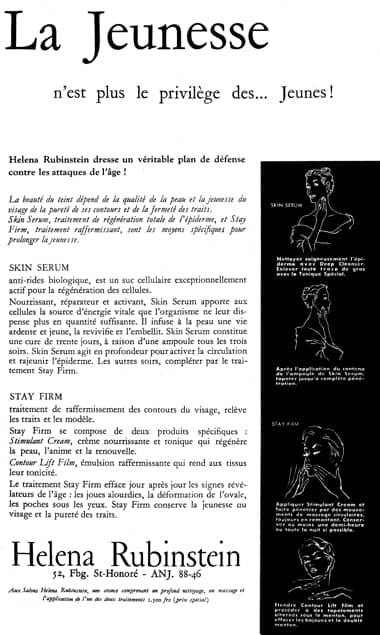
1957 Helena Rubinstein Skin Serum, Stimulant Cream and Contour Lift Film (France).
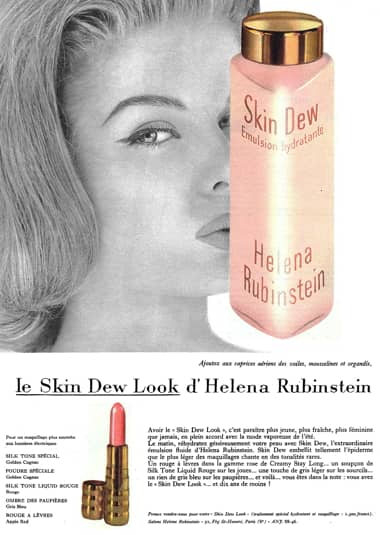
1957 Helena Rubinstein Skin Dew (France).

1957 Helena Rubinstein Cleanse, Nourish and Tone (Britain). Rubinstein could use terms like ‘nourish’ to describe her skin-care cosmetics outside the United States.
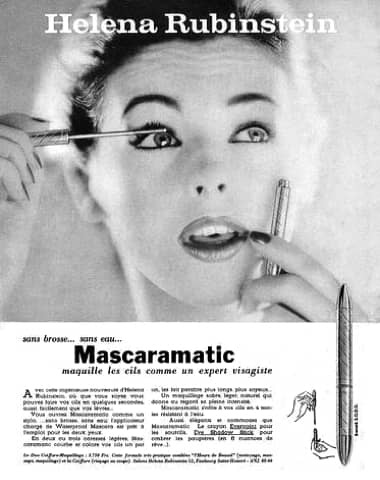
1958 Helena Rubinstein Mascaramatic (France).
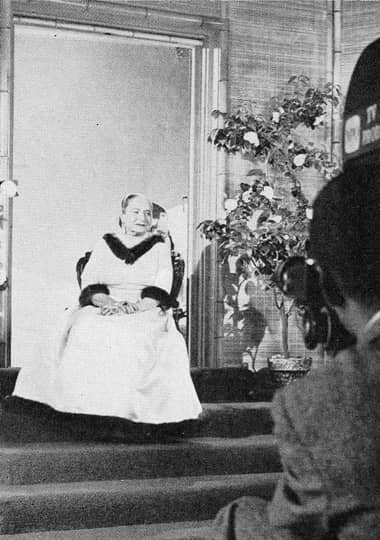
1958 Helena Rubinstein making an appearance on American television. Her segment was prerecorded with her voice dubbed by a Russian actress and Mala Rubinstein’s hands substituted for hers during product shots (Fitoussi, 1010, p. 408).

1958 Helena Rubinstein Bed of Roses lipstick.
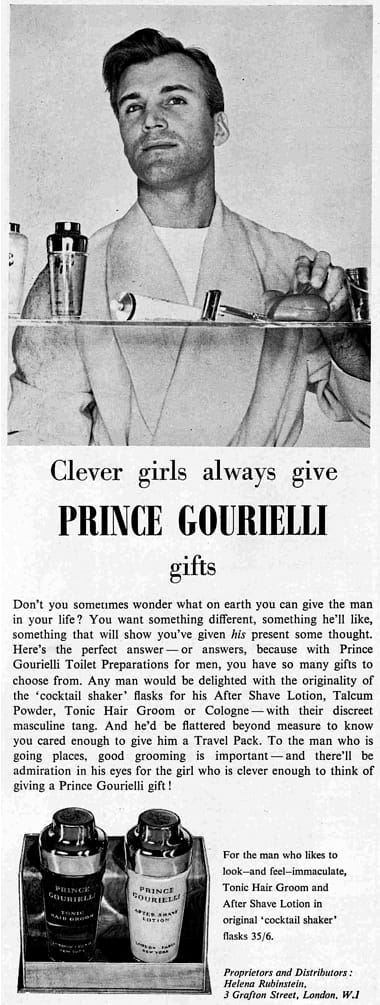
1958 Prince Gourielli (Britain).
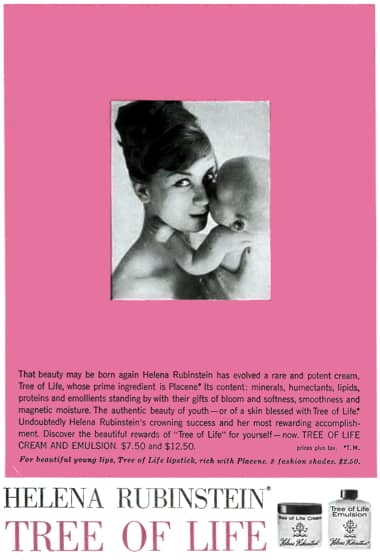
1959 Helena Rubinstein Tree of Life Cream and Emulsion.
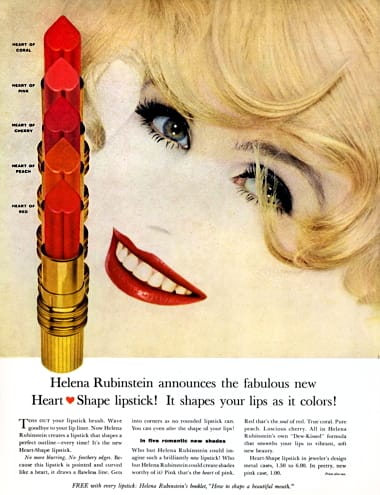
1959 Helena Rubinstein Heart-shaped Lipsticks made with the Dew-Kissed formula using an idea reminiscent of Rubinstein’s earlier Cupidsbow Lipstick (1926). Shades: Heart of Hearts, Heart of Pink, Heart of Bronze, Heart of Peach, Heart of Copper, and Heart of Mandarin.
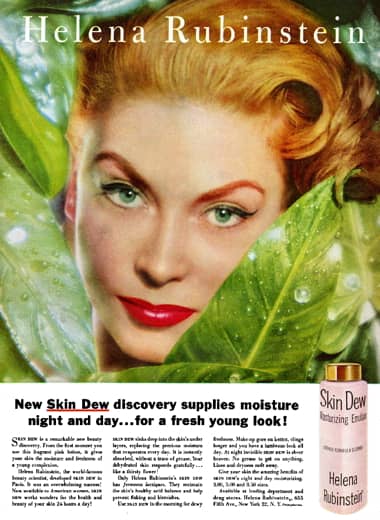
1959 Helena Rubinstein Skin Dew.
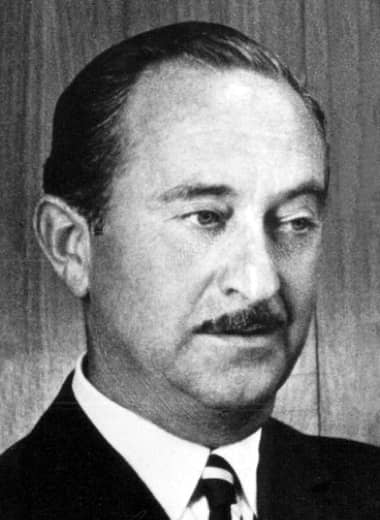
Oscar Szaja Kolin [1908-1995], Rubinstein’s nephew and brother to Mala Rubinstein (Silson) [1905-1999]. After studying chemistry in Paris and Columbia University he began working as a chemist in Rubinstein’s Paris laboratory. He became a director of the American company in 1947 after moving to New York in 1942, and was made the president of the company after Rubinstein’s death in 1965.
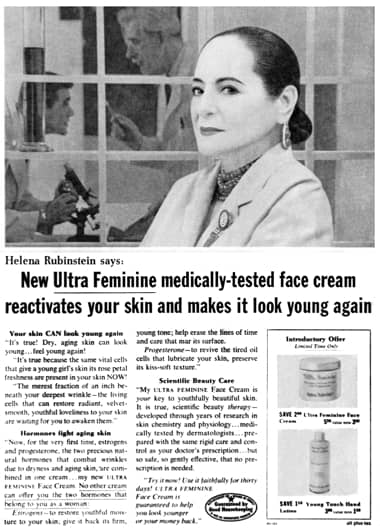
1959 Helena Rubinstein Ultra Feminine.
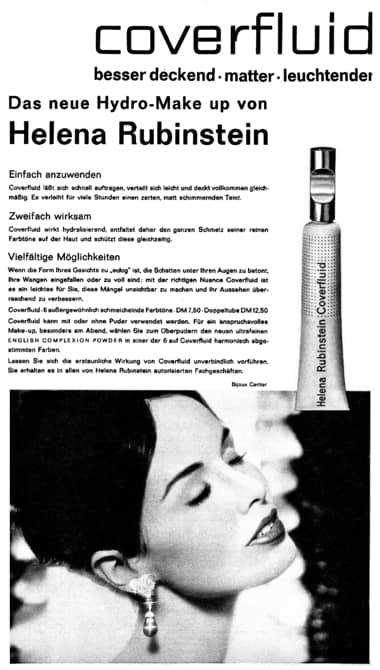
1960 Helena Rubinstein Coverfluid (Germany).

1960 Helena Rubinstein Skin Life Mask (Britain).

1960 Helena Rubinstein Beach Tan sunscreen, Sun & Sport sunburn and windburn cream, and Roll-Dry deodorant (Britain).

1961 Helena Rubinstein Creamessence (Germany).
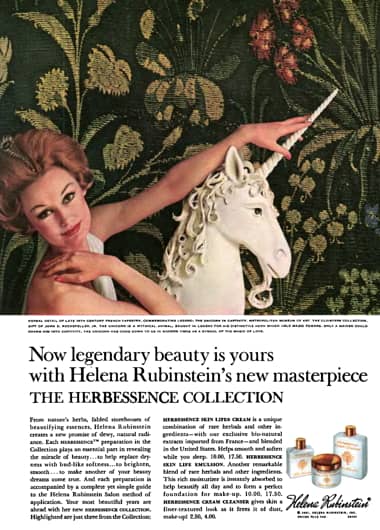
1961 Helena Rubinstein Herbessence Collection.
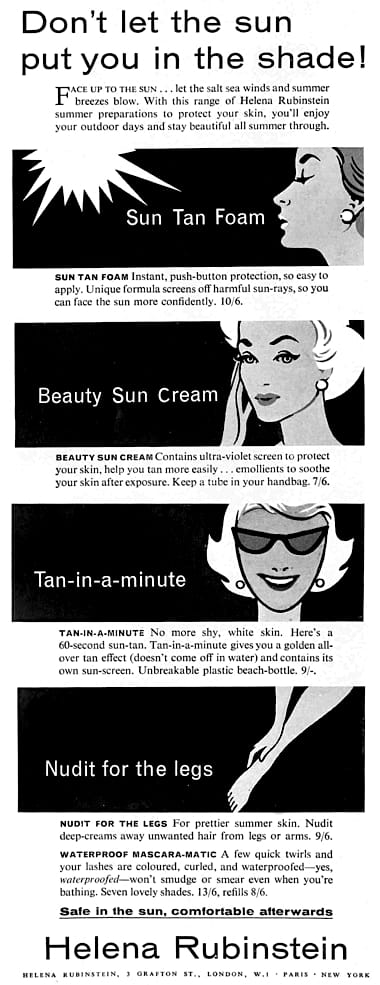
1961 Helena Rubinstein Sun Tan Foam, Beauty Sun Cream, Tan-in-a-minute, and Nudit for legs (Britain).
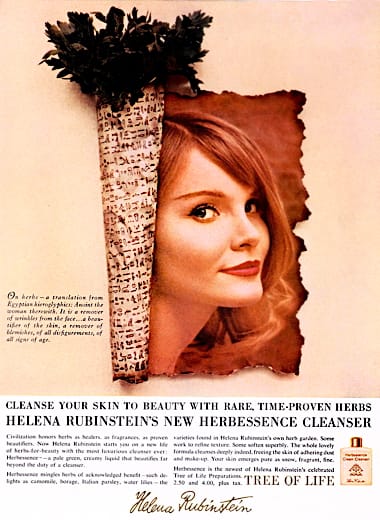
1961 Helena Rubinstein Herbessence Cleanser.
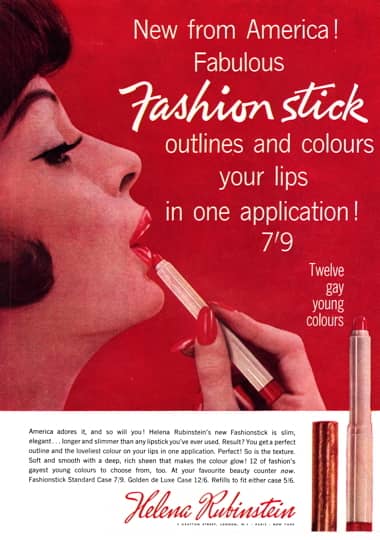
1962 Helena Rubinstein Fashion Stick released one year earlier than Revlon’s Sculptura (Britain). Fashion Stick was oval shaped so that it could act as a lipstick and lipliner in one.
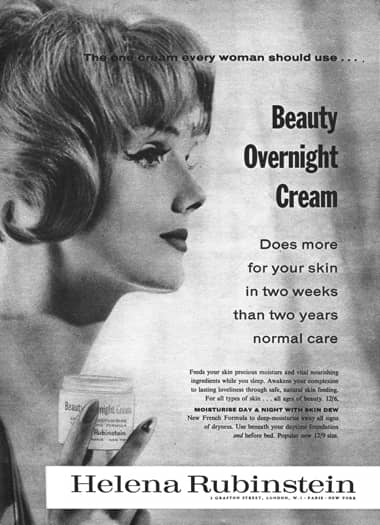
1962 Helena Rubinstein Beauty Overnight Cream (Britain).
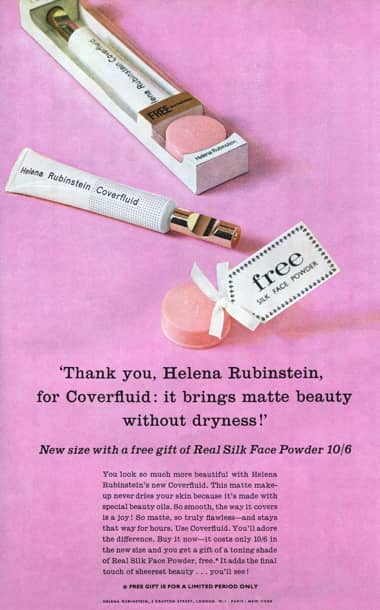
1963 Helena Rubinstein Coverfluid (Britain).
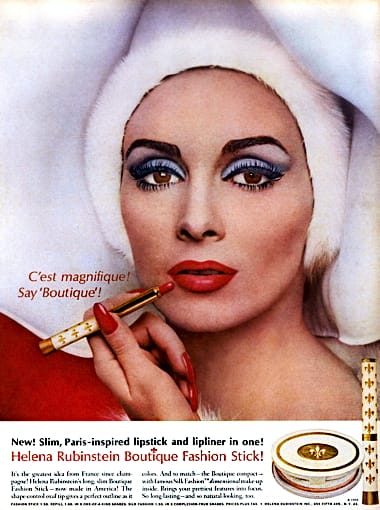
1963 Helena Rubinstein Fashion Stick and Compact.
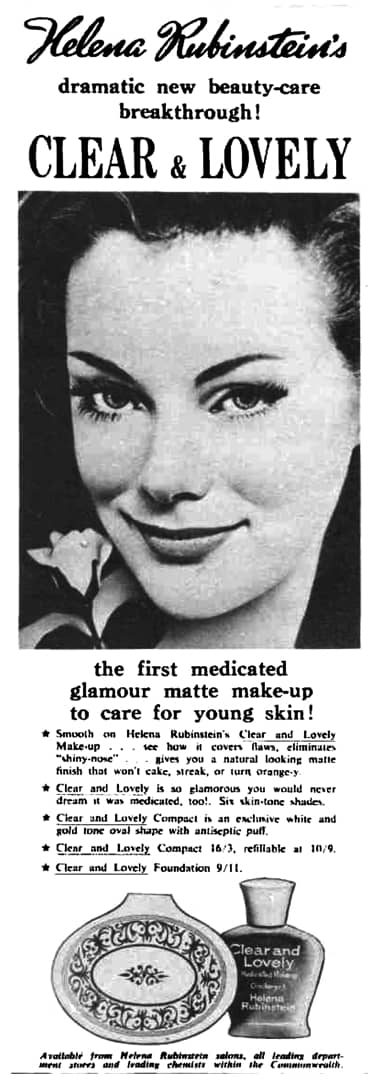
1963 Helena Rubinstein Clear and Lovely Compact and Foundation (Australia).
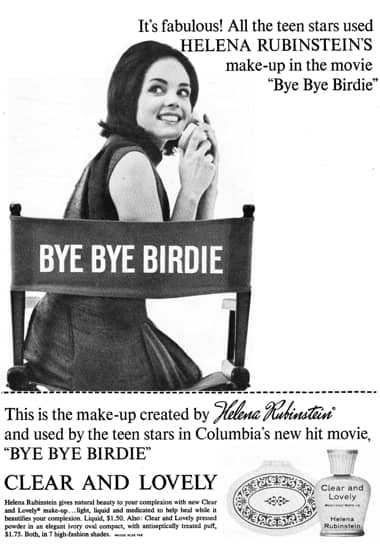
1963 Helena Rubinstein ‘Bye Bye Birdie’ (Columbia Pictures, 1963) promotion for Clear and Lovely.
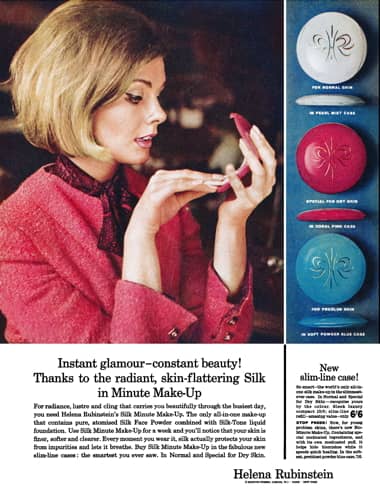
1963 Helena Rubinstein Minute Make-up (Britain).
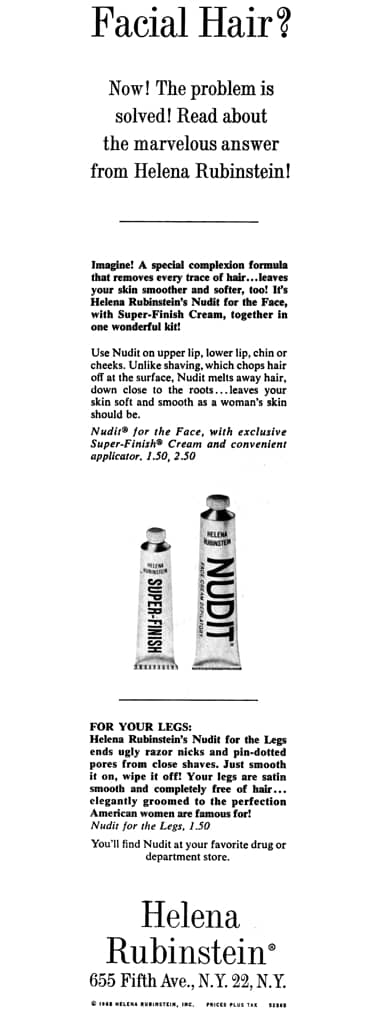
1963 Helena Rubinstein Nudit, known as Nudine in France. Introduced in 1949, Nudit Special for facial hair was added in 1954 with a foaming version called Nudit Shower Off released in 1972.
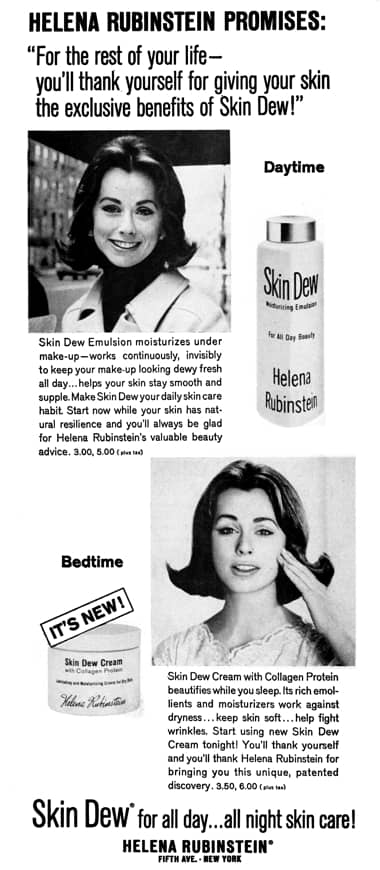
1964 Helena Rubinstein Skin Dew Emulsion and Skin Dew Cream with Collagen Protein.
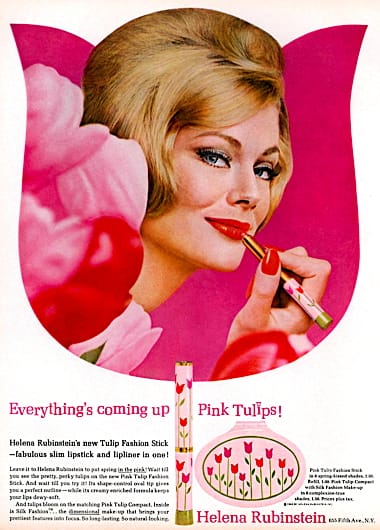
1964 Helena Rubinstein Pink Tulips Fashion Stick and Compact designed to appeal to younger women. Tulip Lipsticks, available in Fashion Stick and Wedding Ring cases were introduced in Amber Tulip, Peachy Tulip, Sunrise Tulip, Coraline Tulip, Blushing Tulip, and Rosiée Tulip shades.
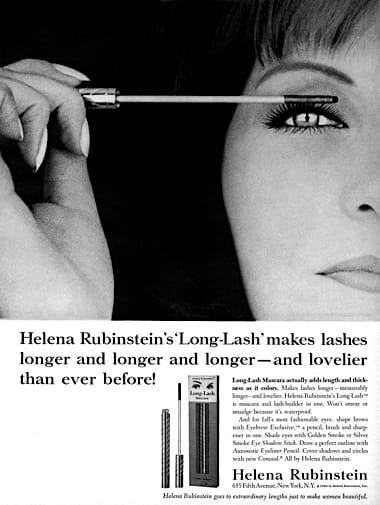
1965 Helena Rubinstein Long-Lash Mascara.
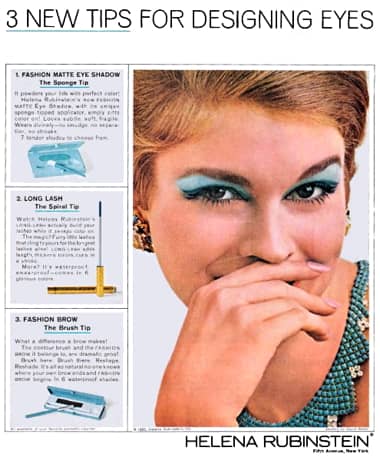
1965 Helena Rubinstein eye make-up.

1965 Helena Rubinstein Super Biodorant. The original Biodorant was a deodorant, this product was an antiperspirant.
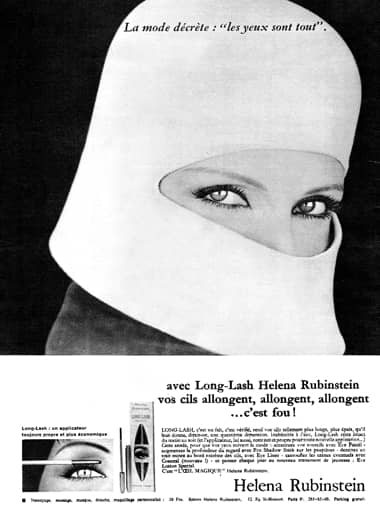
1965 Helena Rubinstein Long-Lash Mascara (French).
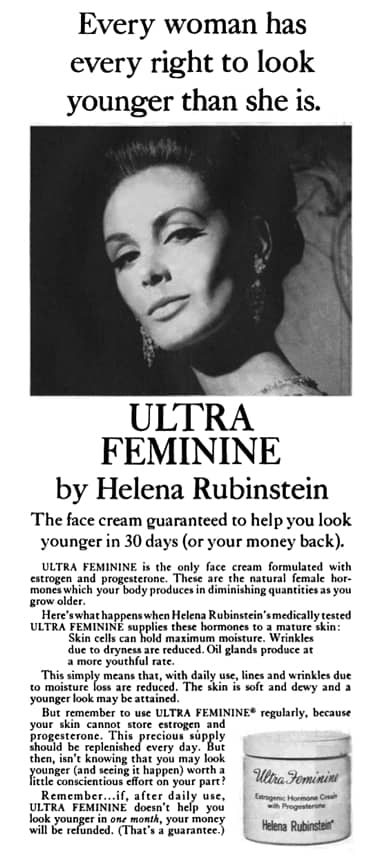
1966 Helena Rubinstein Ultra Feminine, a hormone cream with progesterone.
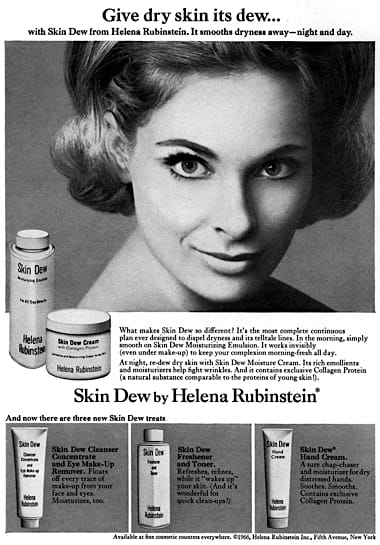
1966 Helena Rubinstein Skin Dew Cleanser Concentrate, Freshener and Toner, and Hand Cream.
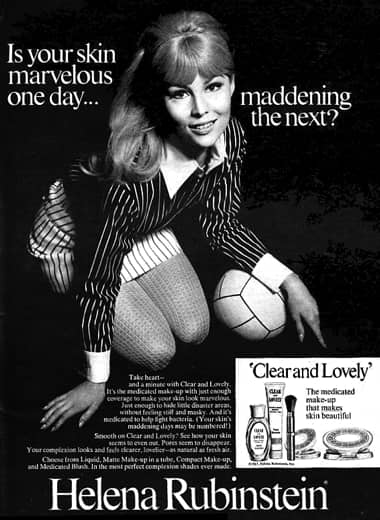
1967 Helena Rubinstein Clear and Lovely medicated make-up.
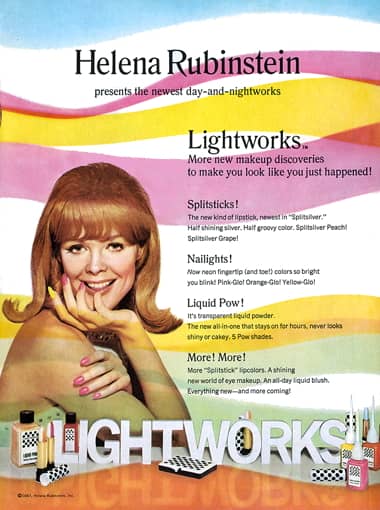
1967 Helena Rubinstein Lightworks.
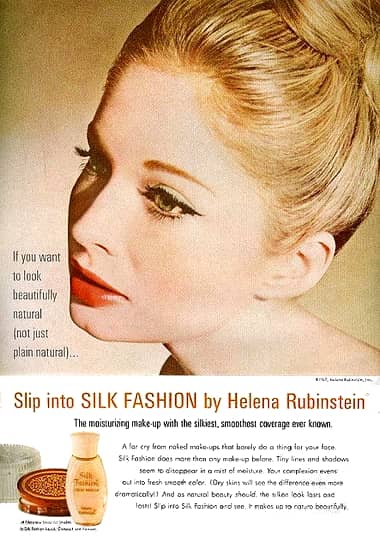
1967 Helena Rubinstein Silk Fashion liquid and compact make-up.
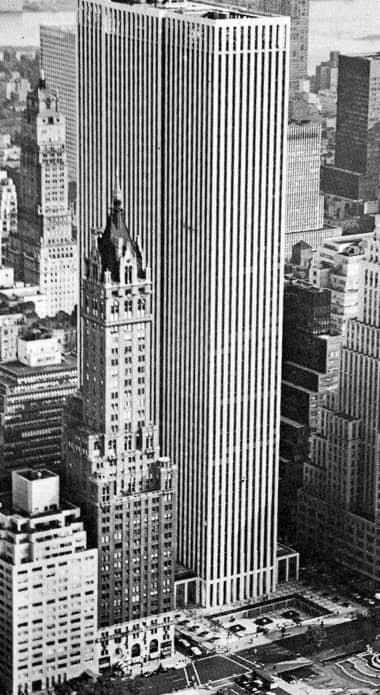
1968 General Motors Building at 767 Fifth Avenue, New York completed in 1968.
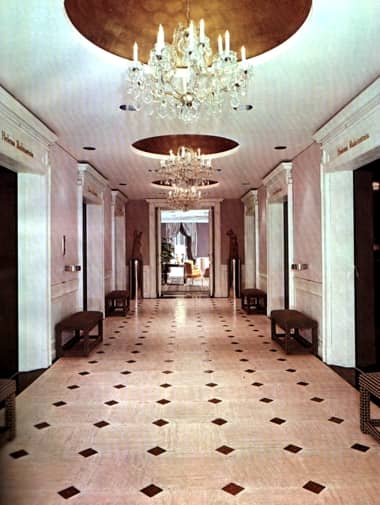
Corridor in the corporate offices of Helena Rubinstein in the General Motors Building looking towards the Reception Room.
